Hear Us Out! Asian Americans, Native Hawaiians, Pacific Islanders, and Their Music
Lesson 5:
Music of the Hawaiian and Pacific Islander Diaspora
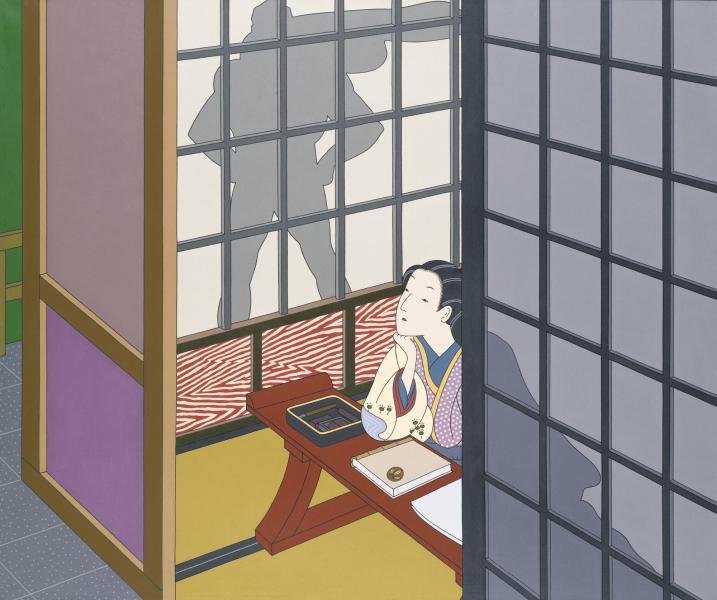

How have Hawaiians influenced the history of popular music in the U.S.?
How does diaspora affect music and culture?
How do people create art that reflects their cultural heritage?

Tafesilafa'i Pacific Islander Festival in Long Beach, CA, by unknown artist. Courtesy of Tafesilafa'i Inc..

Music of the Hawaiian and Pacific Islander Diaspora
CREATIVE CONNECTIONS
30+ MIN
30+ MIN
20+ MIN
HISTORY & CULTURE
MUSIC LISTENING

Paul, Sia, and Koni Taufa at their Church in Laramie, WY, USA. Photo courtesy of Linikoni Taufa.
Hawai'i's Influence on U.S. Popular Music
Component 1

30+ minutes
Kekuku's Hawaiian Quintet, unknown artist. University of Iowa Libraries.


A Musical Introduction

Listen to American Aquarium's "Long Haul" (2020). During the choruses and the instrumental epilogue, you can hear an instrument that plays with a lot of vibrato and gliding between pitches.
What is that instrument?
Where did it come from?

American Aquarium - "The Long Haul" [Official Video]. Uploaded by American Aquarium.
Hawaiian Musicians and Dancers on Tour

The early tours were a part of a plan developed by the U.S. government and businesses to encourage migration to Hawai`i develop the islands as tourist destinations.
Starting in the late 19th century, Hawaiian musicians and dancers--as well as artistic renderings of Hawaiian landscapes--became major attractions on the North American continent.
The “Panorama of Kīlauea” at the Chicago World's Fair in 1893, by Halsey Cooley Ives. Library of Congress.
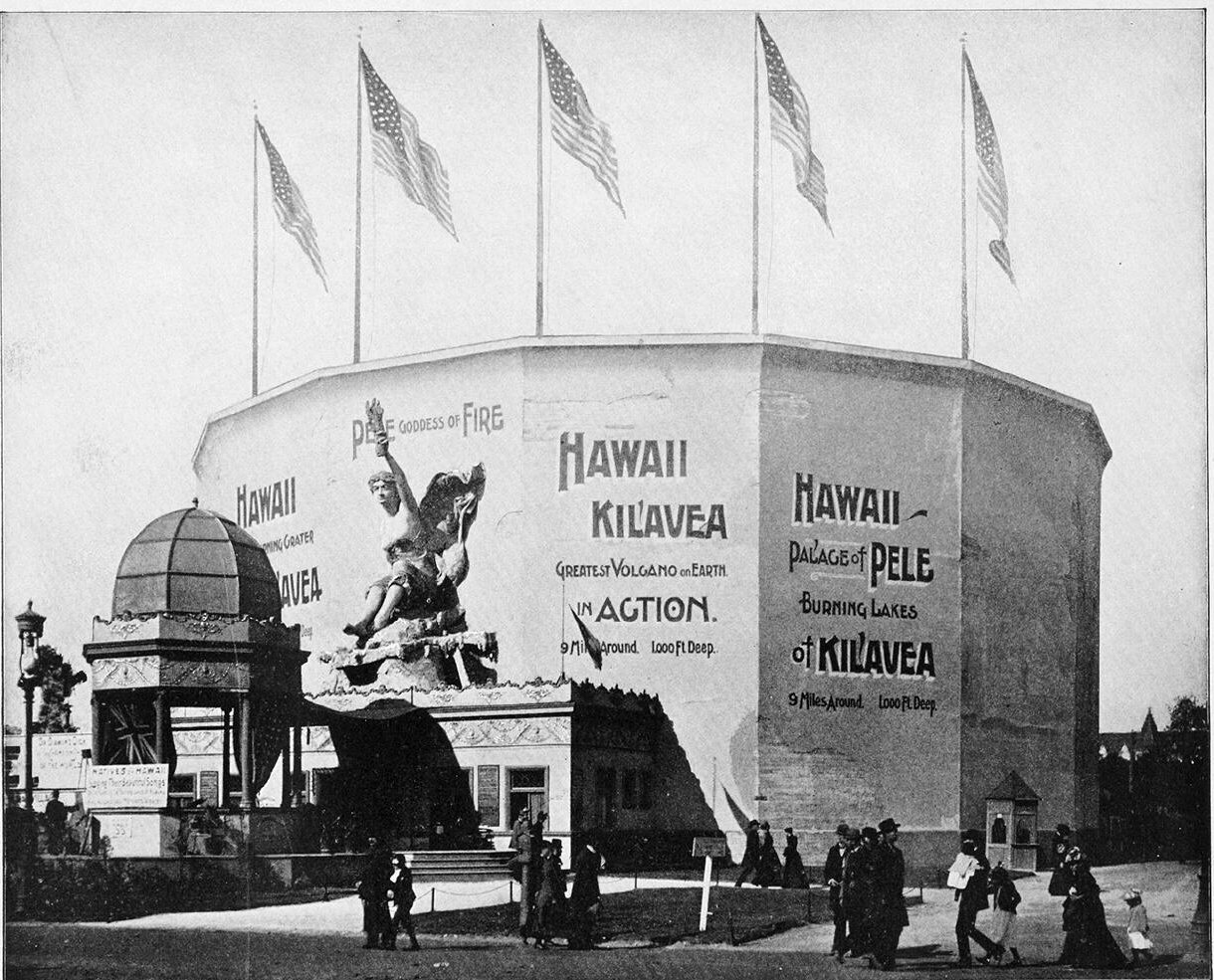

Hula in the Continental U.S.

From 1890 to 1920, westernized versions of hula (see lesson 4) featuring young women attracted large crowds at numerous world's fairs and other venues.
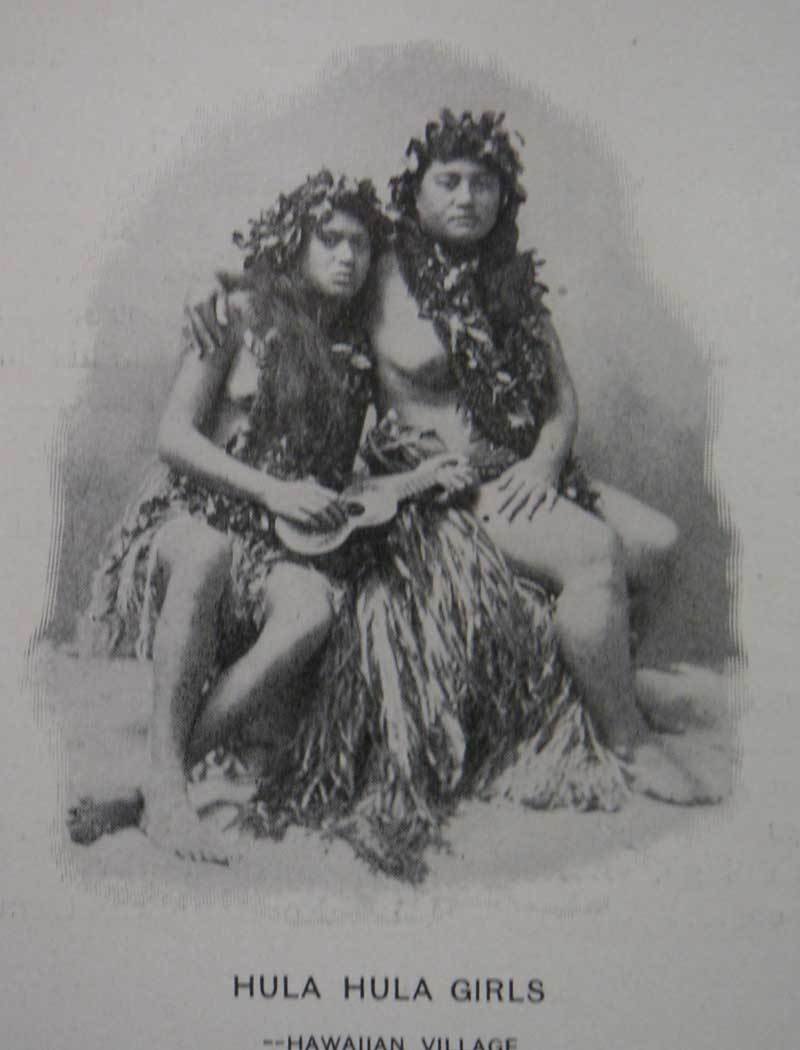

An El Paso Herald article from 1916 (right) shows that many Native Hawaiians were uncomfortable with these hula performances.
Left: Poster for hula show at the Buffalo World's Fair, 1901, unknown artist. Right: Lei and Kashinano Lokalani at the 1916 San Diego Exposition, unknown artist. University of North Texas Libraries.

Hula in the Continental U.S.

From 1890 to 1920, westernized versions of hula (see lesson 4) featuring young women attracted large crowds at numerous world's fairs and other venues.


An El Paso Herald article from 1916 (right) shows that many Native Hawaiians were uncomfortable with these hula performances.
Left: Poster for hula show at the Buffalo World's Fair, 1901, unknown artist. Right: Lei and Kashinano Lokalani at the 1916 San Diego Exposition, unknown artist. University of North Texas Libraries.

Steel Guitar in the Continental U.S.

These Hawaiian performances often also featured a recently invented instrument: the steel guitar (which you heard in the opening video). This instrument is the focus of this component.
Click on the photo to listen to a recording made by Joseph Kekuku and John K. Pa'aluhi in 1909.
Developed by Joseph Kekuku in the late 1880s/1890s, the instrument reached the U.S. mainland by the turn of 20th century. Kekuku himself toured the U.S. mainland from 1904 to 1919. After touring in Europe, he returned to the U.S. mainland, and died in New Jersey in 1932.

Kekuku's Hawaiian Quintet, unknown artist. University of Iowa Libraries.
What is a Steel Guitar?

When playing the steel guitar, the dominant hand plucks the strings (fingers or picks), while the non-dominant hand holds a steel bar, which is used to press lightly against and slide along the strings.
Bobby Ingano "Waipio Beyond the Rainbow" @ Maui' Slack Key Show. Uploaded to YouTube by Slack Key Show - Napili.
Steel guitar is known for its distinctive timbre, the relaxed gliding between pitches, and vibrato techniques that allow the instrument to imitate the voice.

Hawaiian Artists Leave the Islands

After the overthrow of the Queen Liliuokalani in 1893 and the U.S. annexation in 1898, many Hawaiian musicians and dancers went to North America and Europe.
Full Page ad in Popular Mechanics Magazine for guitar lessons Dec 1923 p 55, unknown artist. Popular Mechanics Magazine.
If they stayed, their career opportunities were most likely limited to plantation work or bureaucratic work supporting a government that colonized them. If they left, they could perform, see the world, and continue to practice Hawaiian traditions.
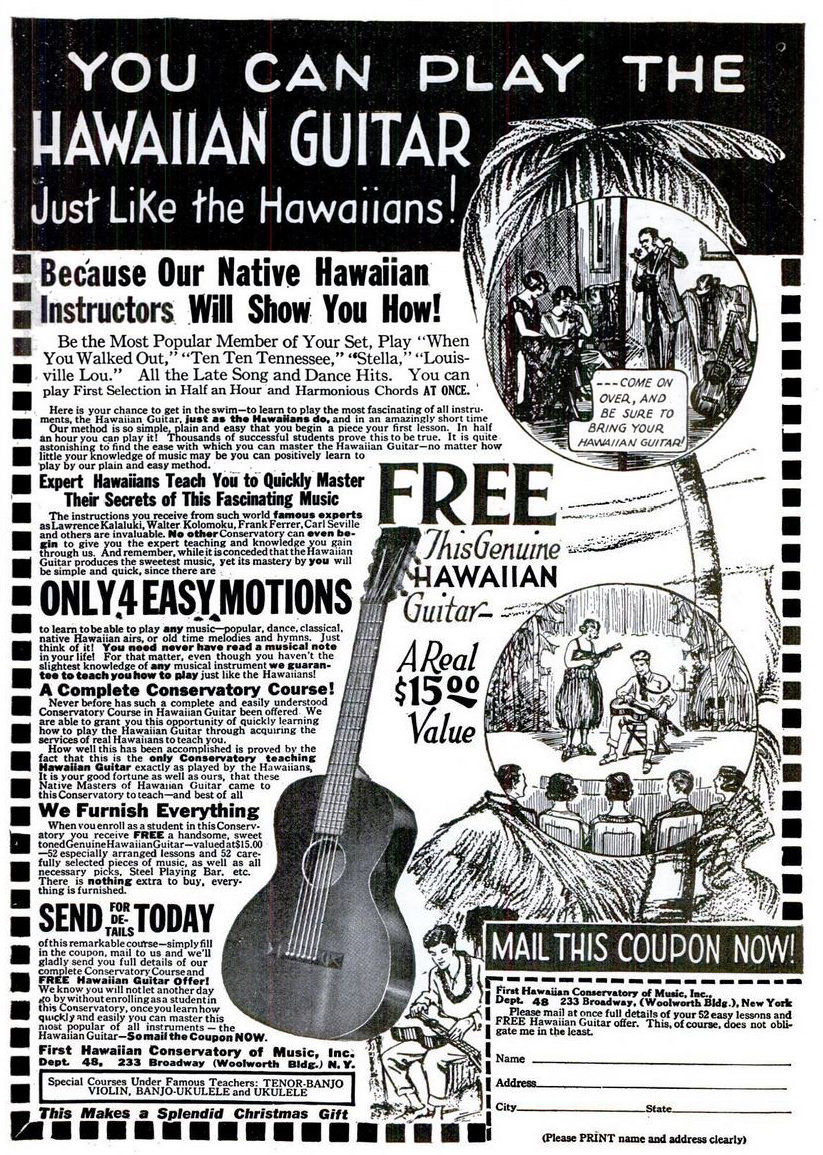

"Ethnic Novelty" as Entertainment

Central to turn-of-the-20th-century entertainment in the United States are "ethnic novelty" songs and skits. These use ethnic stereotypes for comic or satiric purposes. From our 21st-century perspective, we can see that most of this repertory--which includes blackface minstrelsy and orientalist songs--is extremely offensive and harmful.
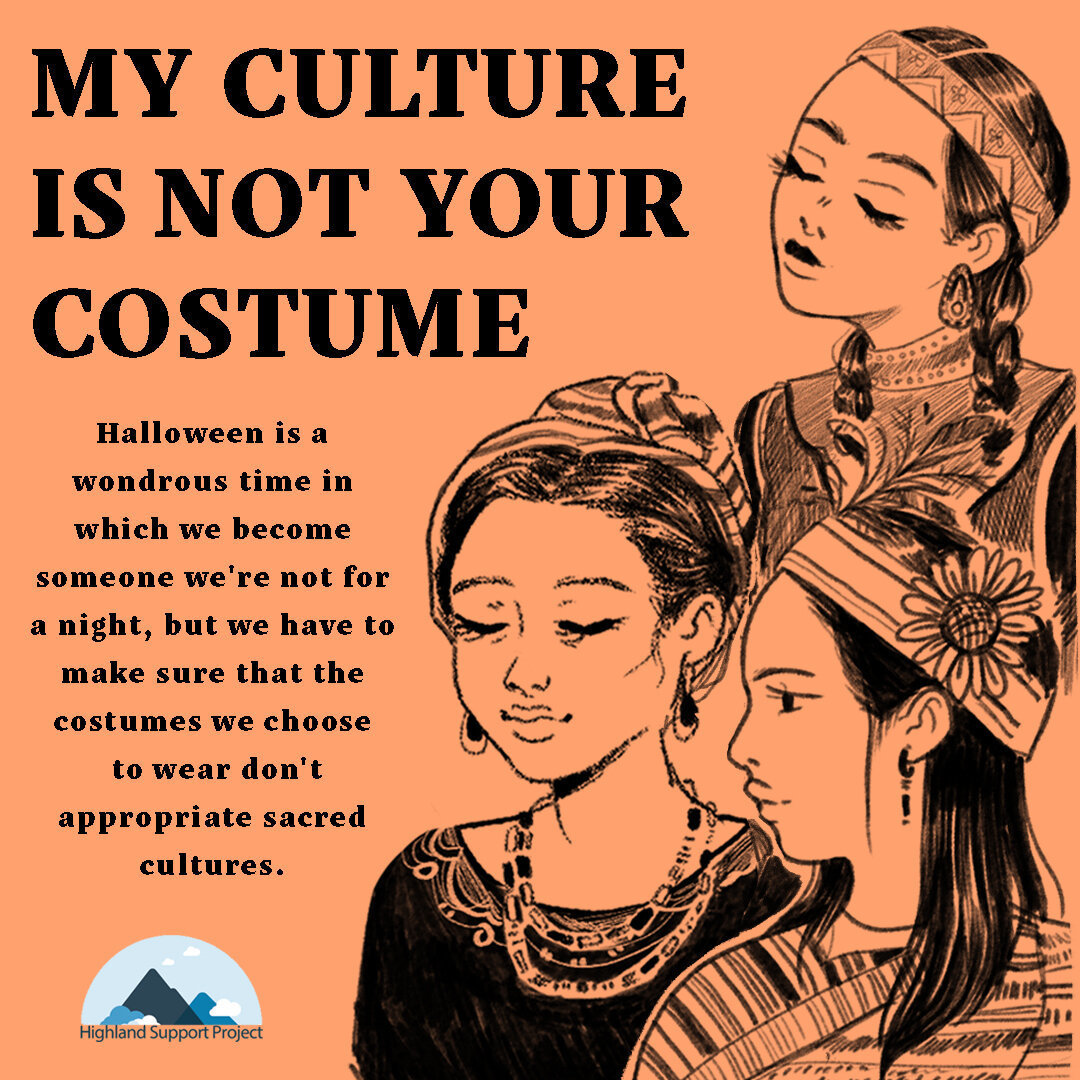
My Culture is Not Your Costume, by Kylie Love Gatchalian. Highlands Support Network.

"Ethnic Novelty" and Hawaiians

Aloha Oe, by unknown artist. Public Domain {{PD-US}}, from the New York Public Library.
At the turn of the 20th century, many Americans believed in the stereotype that Native Hawaiians were "primitive." This was extremely harmful, and contributed to the colonization of the islands.
However, the stereotype also helped Hawaiian musicians and dancers enter the music industry. An example is the sheet music on the right.
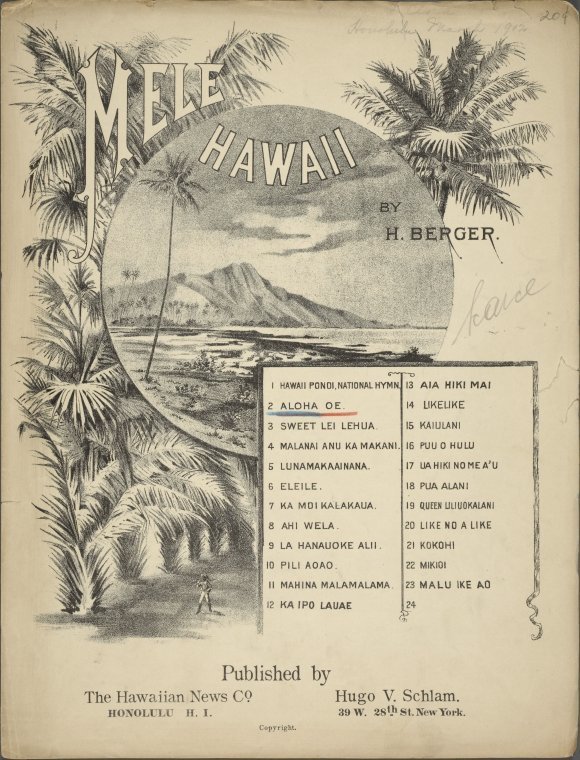

Steel Guitar and "Ethnic Novelty"

John Troutman, the leading expert on steel guitar music and whose research informs much of this component, wrote:
"...the Hawaiian steel guitar was one of the most modern and cutting-edge instruments available to entertainers on the popular stage. The dissonance between the instrument's modernity and white audiences' assumptions of Hawaiian inferiority remained palpable..." (Kīkā Kila, p. 76)
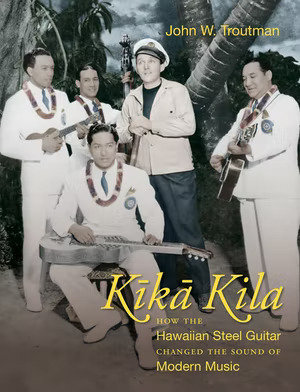
Cover for Kīkā Kila: How the Hawaiian Steel Guitar Changed the Sound of Modern Music. Image courtesy of Lani Ellen McIntire and HLC Properties, Ltd. The University of North Carolina Press.

"Language" as Resistance

Despite the fact that the vogue for "ethnic novelty" was what created the U.S. market for Hawaiian musicians, many Hawaiian musicians used music as a form of resistance.
"AKAHI HOI, Toots Paka Hawaiian Troupe levytti 6.11.1914," uploaded to YouTube by Dallape30.
From 1909 to 1915, the Toots Paka Hawaiian Troupe, which included Joseph Kekuku for a time, focused on Hawaiian-language repertory. For a 1909 session, a third of the songs were by members of the monarchy that U.S. businessmen overthrew in 1893.

The Wild Popularity of "Hawaiian" Music

Steel guitar was popularized through the vaudeville circuit––for example, the play Bird of Paradise toured not just in theaters but in tents in rural areas, pedagogical materials, major events like the San Francisco International Exposition in 1915, and recordings.
"Have You Heard the New Fascinating Hawaiian Music?" in The Evening Herald., June 09, 1916. Library of Congress.
In 1916, Hawaiian guitar recordings outsold every other genre of recording in the U.S.
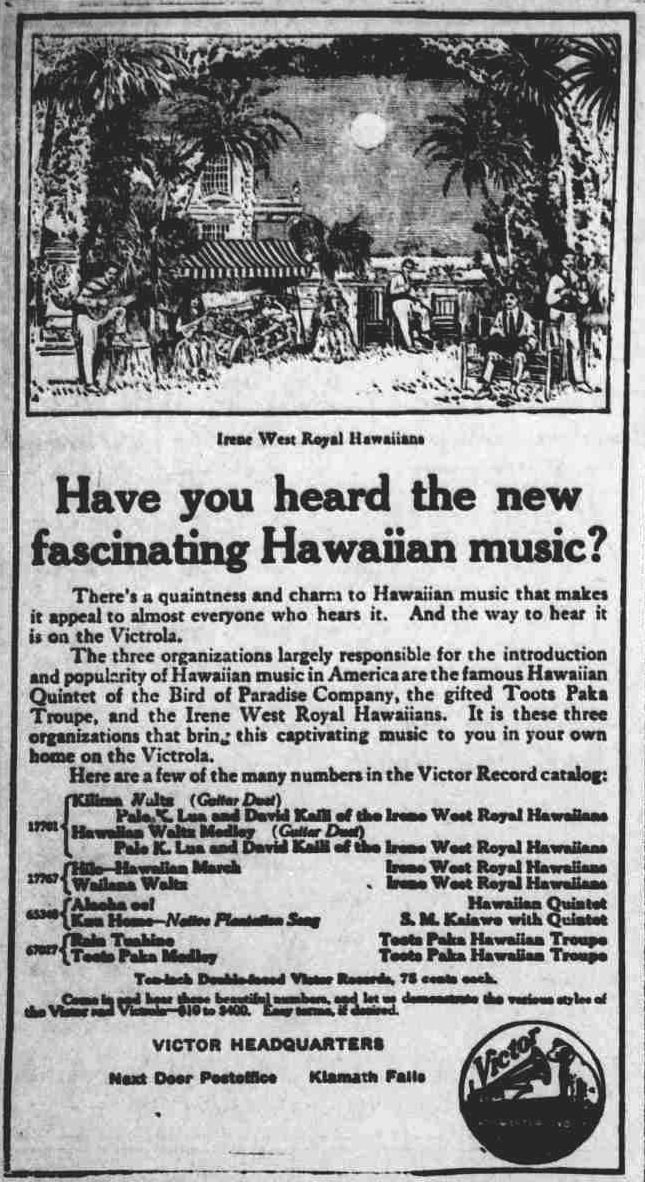

John Troutman on the Influence of Steel Guitar

"The reach of Hawaiian guitarists into the heart of local music-making in the United States cannot be overestimated, and is demonstrated by the ways Americans assimilated and adapted the instrument to redefine the sonic contours of their own vernacular traditions, much as Hawaiians had adapted the Spanish guitar into their own." (Kīkā Kila, p. 155).

Hawaiian Steel Guitar Classics 1927–1938. Cover art by Wayne Pope, photograph by Sam Ku West. Arhoolie Records.

Sol Hoʻopiʻi: "Palolo"

Sol Hoʻopiʻi was one of the stars of the second generation of steel guitar virtuosos. "Palolo" was recorded by his trio in 1927. As you can hear in this recording, his style was influenced by jazz.
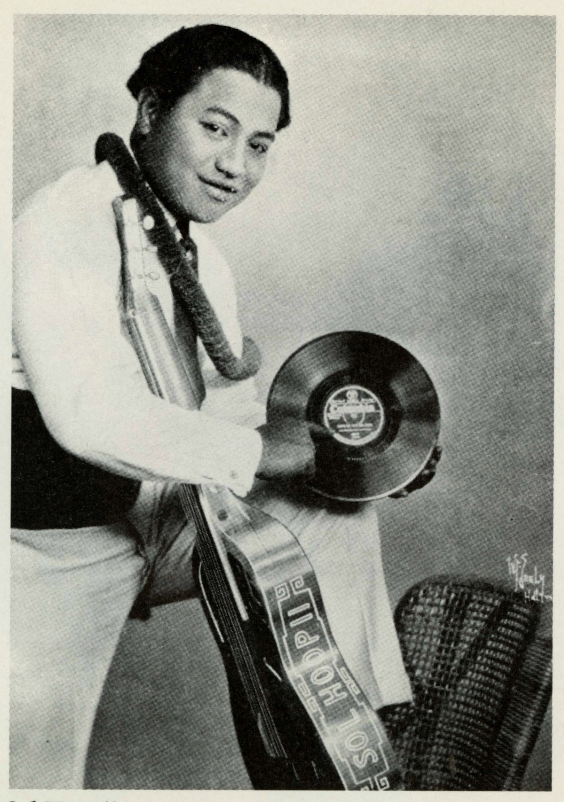
Sol Ho'opi'i, unknown artist. Arhoolie Records.

Steel Guitar in the American South

Early radio also featured Hawaiian musicians.
Vierra's Hawaiians: delightful interpretors of the music of the South Seas, unknown artist. University of Iowa Libraries.
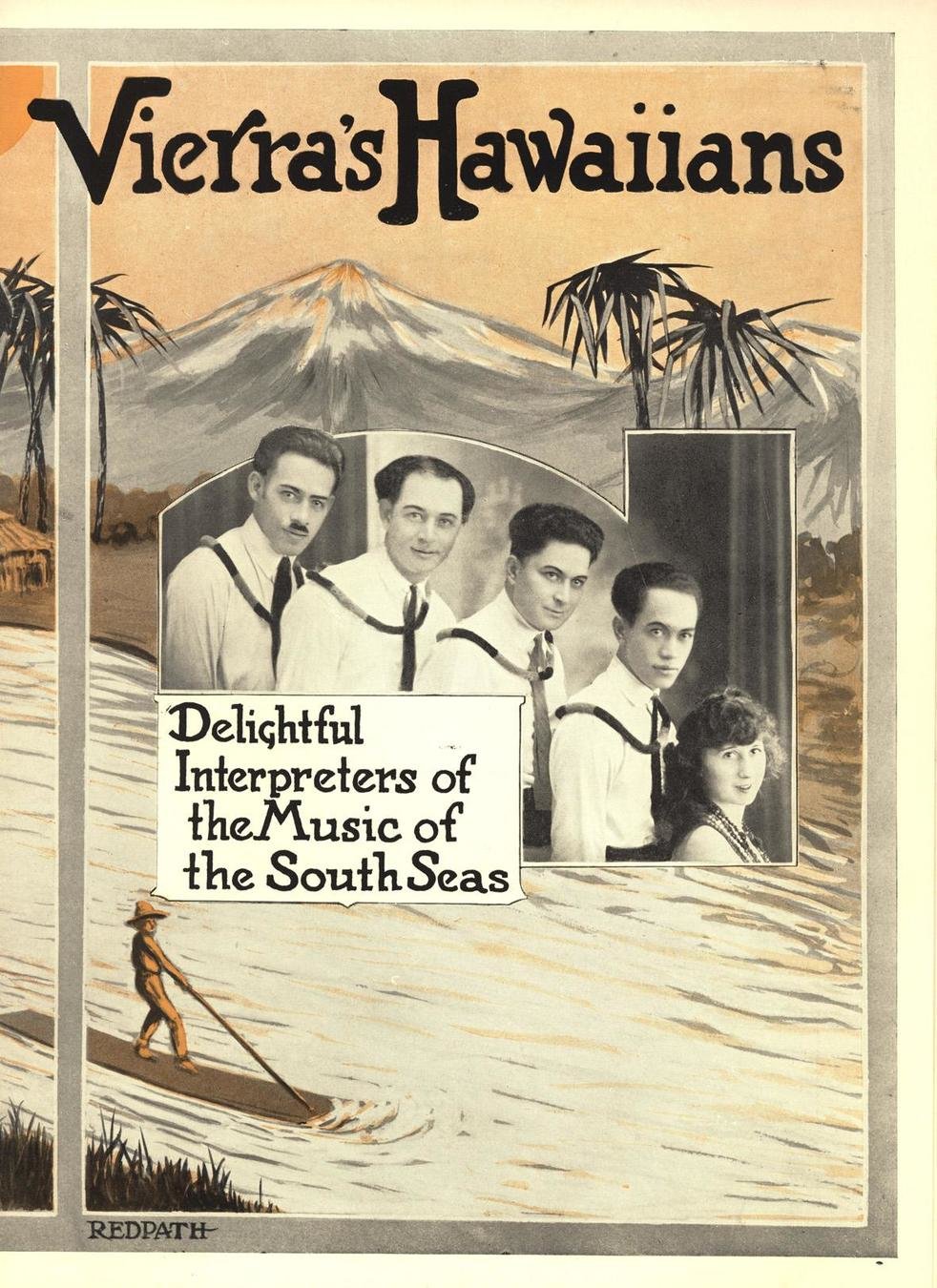

In 1884, the Royal Hawaiian Band became the first Hawaiian group to give a concert in the American South.
Hawaiian shows continued sporadically in the 1890s, and increased dramatically in the 20th century: They were performed in cities of all sizes and also in rural locations.
Influences Between Steel Guitar and Jazz

Given the frequency with which Hawaiian musicians performed in cities like New Orleans, it is no surprise that jazz and Hawaiian musicians influenced each other.
Here, you will hear the steel guitar in Louis Armstrong's "I'm in the Market for You" and Fats Pichon's "Dad Blame Blues." For you, what is the effect of the steel guitar in these recordings?

Race-Based Music Industry Categories

When record companies began recording vernacular music in the American South in the 1920s, they decided to categorize musicians on the basis of race:
- "Race Records" were recordings of Black musicians, and were marketed primarily to Black consumers
- "Hillbilly"/"Old-Time" records were made by Southern White musicians, and were marketed primarily to Southern Whites
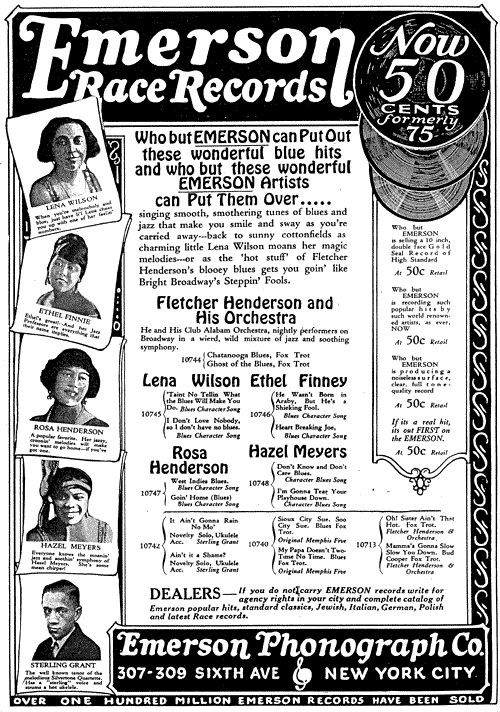
1922 Chicago Ad for Emerson Race Records, unknown artist, via the78rpmrecordspins

Discussion Questions

How is genre defined in the U.S. music industry today?
- Hip Hop
- Western Classical Music
- Singer-songwriter
- Country Music
Do you have any preconceptions about the identity (gender, race, class, age) of the performers in the following genres?:
- Indian Classical Music
- K-Pop
- Jazz
- Musical Theater
If you have preconceptions, how were they formed? Do/should these preconceptions play a role in how we understand the genre?

The Impact of Music Industry Categories

The adoption of race-based categories played a significant role in the writing of popular music history. The complexities of race relations in the American South were largely erased in dominant narratives about U.S. popular music.
The International Sweethearts of Rhythm Album Cover, unknown artist, Rosetta Records. Library of Congress.
Throughout the history of U.S. popular music, White and Black musicians influenced each other all the time. Even during the Jim Crow era, many played in mixed-race sessions.
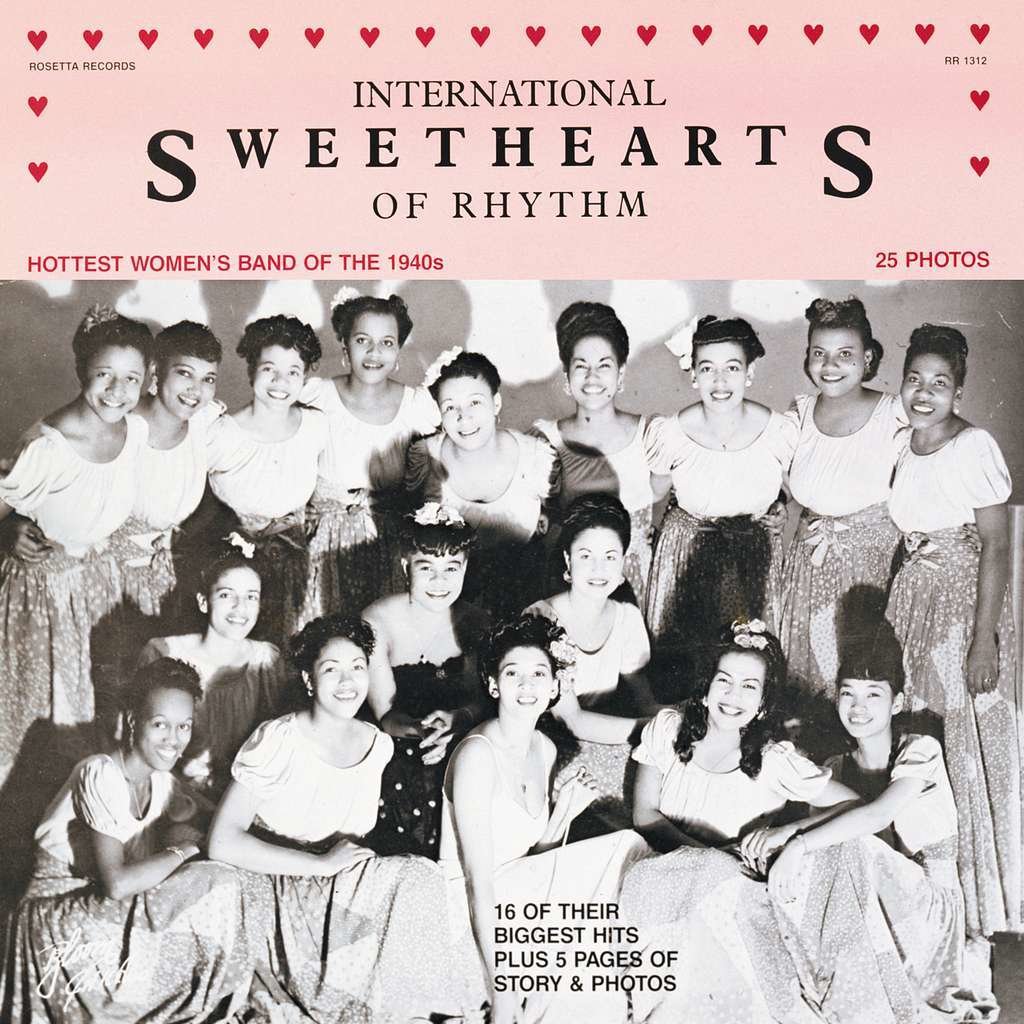

The Role of Native Hawaiians in Musical Collaborations

For the purposes of this lesson, what is important to remember is how much both White and Black musicians in the South were heavily influenced by Native Hawaiian steel guitar musicians.
We cannot be 100% certain that--prior to meeting Native Hawaiian musicians--Southern musicians never used some sort of bar to control the pitches on a guitar. However, we can be sure that Hawaiians helped them master the technique.
The Six and Seven-Eight String Band, designed by Ronald Clyne. Folkways Records.

"Medley in D" - Hawaiian Guitar Solo

This recording captures the popularity of Hawaiian steel guitar in the American South in the early 20th Century.
Listen to "Medley in D," an early piece in the repertory of the Six and Seven-Eight String Band of New Orleans.
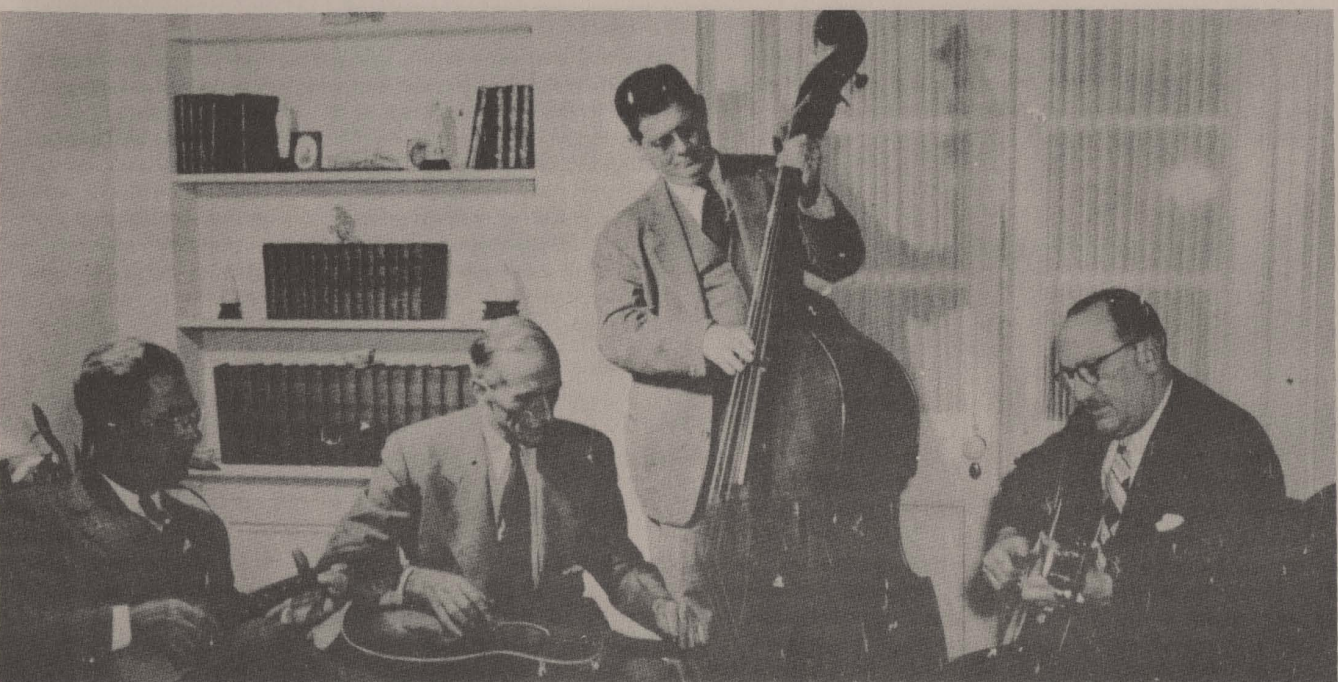
The Six and Seven-Eight String Band, unknown artist. Folkways Records.
What do you notice about musical characteristics and expressive qualities in this recording?

The Evidence

Troutman's research lays out many sources of information for the influence of Native Hawaiian musicians on Southern vernacular music:
- Oral histories in which many Southern musicians discuss the "Hawaiian style"
- Many pictures of Southern guitarists playing by laying the guitar on their laps
- Recordings of Hawaiian songs by many Southern musicians
- Popularity of Hawaiian music on radio

The Slide Guitar

As soon as Southern musicians learned the Hawaiian style, many began adapting it to make the instrument fit their traditions better.
Some blues musicians developed the slide guitar, which allowed them to play "Hawaiian style" on some strings and to finger the frets on others. They are played in the standard guitar position.
Son House "Death Letter Blues". Uploaded to YouTube by GtrWorkShop.

The Dobro

A Dobro, or resonator guitar, allowed the instrument to be louder without electricity. This amplification is created by a single outward-facing resonator cone, which fills up most of the lower half of the guitar's body.
Today, Dobros are used primarily in bluegrass.
"Gene Wooten - Foggy Mountain Rock." Uploaded to YouTube by grassliker.

Console Steel Guitar

In the 1930s, guitarists started demanding steel guitars that would allow them to switch keys and tunings quickly. The result is a console guitar with two or more guitar necks. Notable early console steel guitar virtuosos include Alvino Rey, Leon McAuliffe and Don Helms.
"Leon McAuliffe And Cimarron Boys - Take it Away, Leon 1959". Uploaded to YouTube by When The Cowboy Sings.

Pedal Steel Guitar

To provide steel guitarists even more flexibility, manufacturers started adding pedals to console steel guitars. These pedals allow players to adjust the tension of the strings, thereby altering the pitch.
Pedal steel guitar is most common in country music, but is used in many other genres, including jazz, sacred music, and various African popular traditions.
Nigerian musician Demola Adepoju is best known as the steel guitarist for King Sunny Adé and His African Beats. "Moji" is from his 1985 solo album, Olufe-Mi.
Since the 1930s, the steel guitar has been central to African American Holiness-Pentecostal praise music. The Campbell Brothers have been leading practitioners of this tradition since the 1990s. This recording of "I've Got a Feeling" features singer Katie Jackson.

Reflection

I hope this component has demonstrated the tremendous influence of Hawaiian steel guitars on U.S. popular music. This instrument and its descendants continue to be essential in many musical traditions today.
Given its significance, why is Hawai`i largely absent in standard narratives about U.S. popular music?
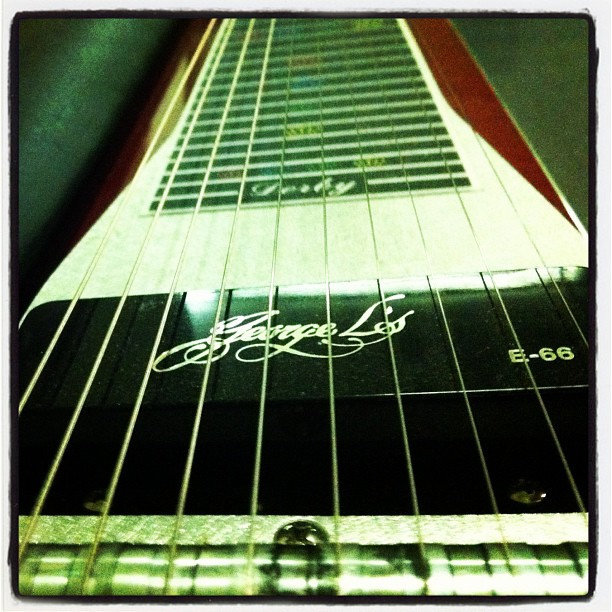


Learning Checkpoint
- What factors led to the exodus of many musicians from Hawai`i, and what factors allowed them to be successful in the U.S. popular music industry?
- How did Hawaiian musicians influence jazz, country music, and the blues?

- How did musicians in the continental U.S. adapt the Hawaiian steel guitar for their needs?
- How do you play the Hawaiian steel guitar? What does it sound like?
End of Component 1: Where will you go next?





Component 2

30+ minutes
Euphonium Player Linikoni Taufa Performs in a Brass Band in Tonga. Photo courtesy of Linikoni Taufa.
Diaspora and Music: Brass Bands in the South Pacific and Beyond

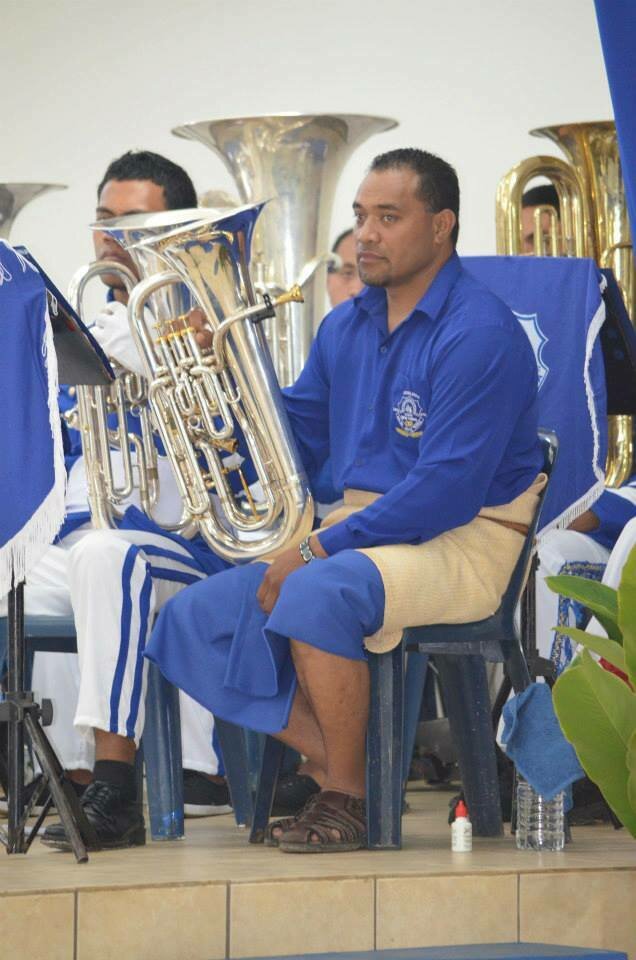
Pacific Islands and Imported Traditions


European colonization and missionization during the 19th Century brought three types of music to most Pacific Islands cultures:
- Hymnody / Choral music
- Guitars
- Bands / Brass bands
Different cultures adopted and adapted these traditions in contrasting ways.
Top Left: Tongan Brass Band, unknown artist. Top Right: A Choir Rehearses in Samoa, Ad & Lucia Linkels. Folkways Records. Bottom: Hoot Gibson, unknown artist. Arhoolie Records.

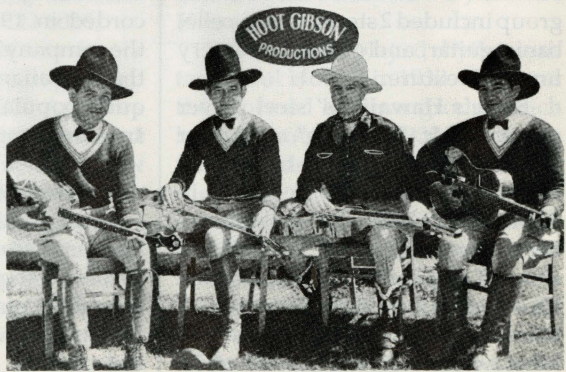
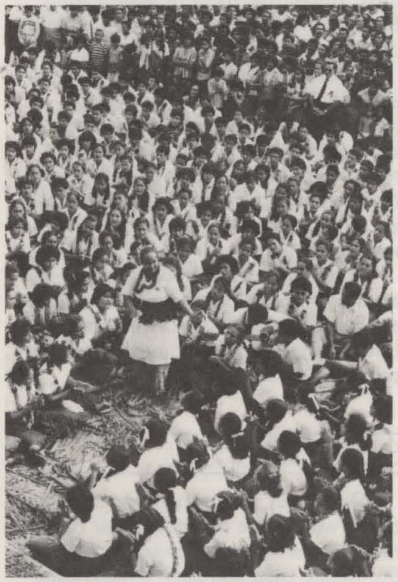
Choral Music


In this video, a choir from Fiji (Pacifka Voices) sings "People of the Sea" by Igelese Ete and Jacki Mua.
Guitar


In this video, Hawaiian Steel Guitar Master Bobby Ingano performs "Waipio Beyond the Rainbow."
Visit Component 1 of this lesson for an in-depth look at the Hawaiian steel guitar tradition.
Bands


In this video, the Tupou College Brass Band (Tongatapu, Tonga) performs "12th Street Rag."
The remainder of this component will focus on bands.
Brass Bands in the Pacific Islands: Hawai'i


Arguably, the best-known band in the Pacific Island region is the Royal Hawaiian Band, which was founded by King Kamehameha III in 1836. It is the only full-time municipal band in the United States.
The band's tours in the late 19th century were instrumental in introducing U.S. audiences to Hawai`i.
The Royal Hawaiian Band in 1889, unknown artist. {{PD US}}, via Wikimedia Commons.

Brass Bands in the Pacific Islands: Samoa


Located almost 2,500 miles northeast of the Australian coast, Samoa (not to be confused with American Samoa) was colonized by Germany (1900-14) and New Zealand (1914-62). It was the German government that established the brass band tradition.
The Fatuasi Brassband (Samoa) performs "Velo Mai Lau Disco" (1982). Written by the band's leader, the piece was inspired by disco.
Today, some brass bands in Samoa play official functions. There are also many village- and church-based bands that play all sorts of secular and religious music.

Samoa Globe View. University of Texas Libraries.
Brass Bands in the Pacific Islands:Tonga


The Kingdom of Tonga is located just over 2,000 miles east of Brisbane, Australia. It consists of 169 widely scattered islands, of which 36 are inhabited.
Its population is around 105,000, and 97% are ethnically Tongan. 70% of the population live on the island of Tongatapu, which is at the southern end of the archipelago.
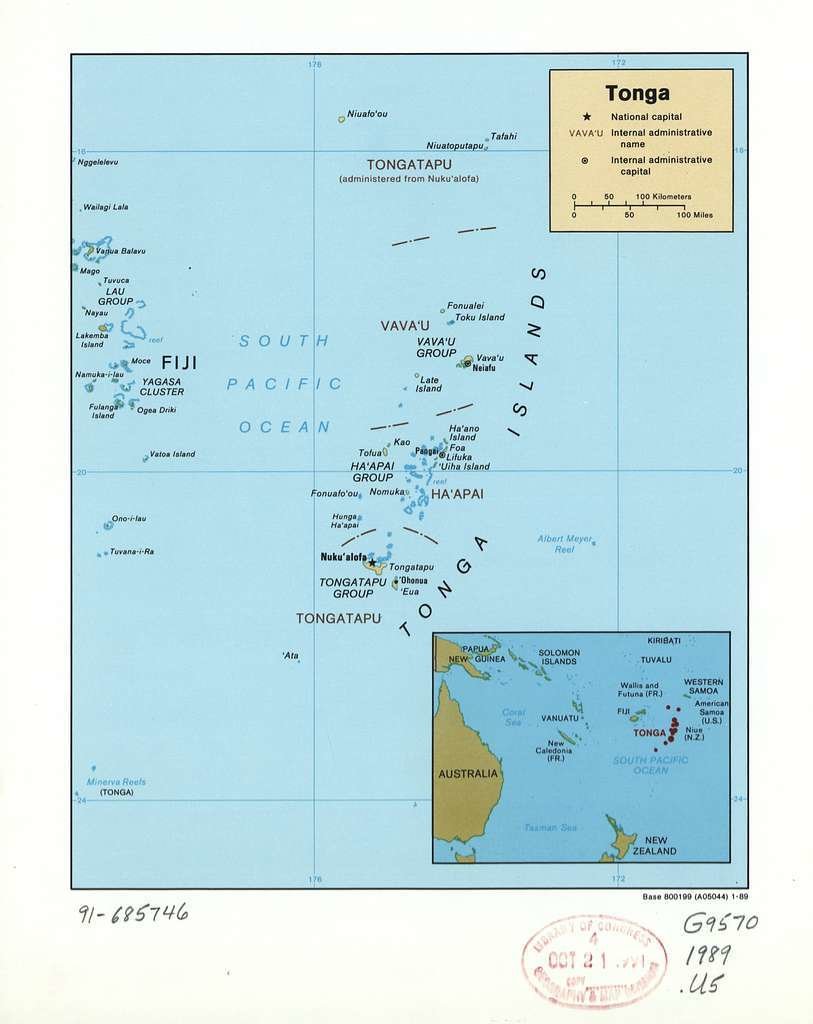
Tonga. Historic Map. Public Domain, {{PD US}}, Library of Congress.
Historical Context: Tuʻi Tonga Empire


Tonga was the center of a maritime empire that peaked between around 1200CE and 1500CE. There were frequent exchanges of goods and ideas between the many island kingdoms in the South Pacific.
The Tongan kings also demanded and received tributes (gifts) from other kingdoms in the region. Tributes were given at Inasi ceremonies. Captain Cook witnessed one of these ceremonies in 1777 (pictured here).
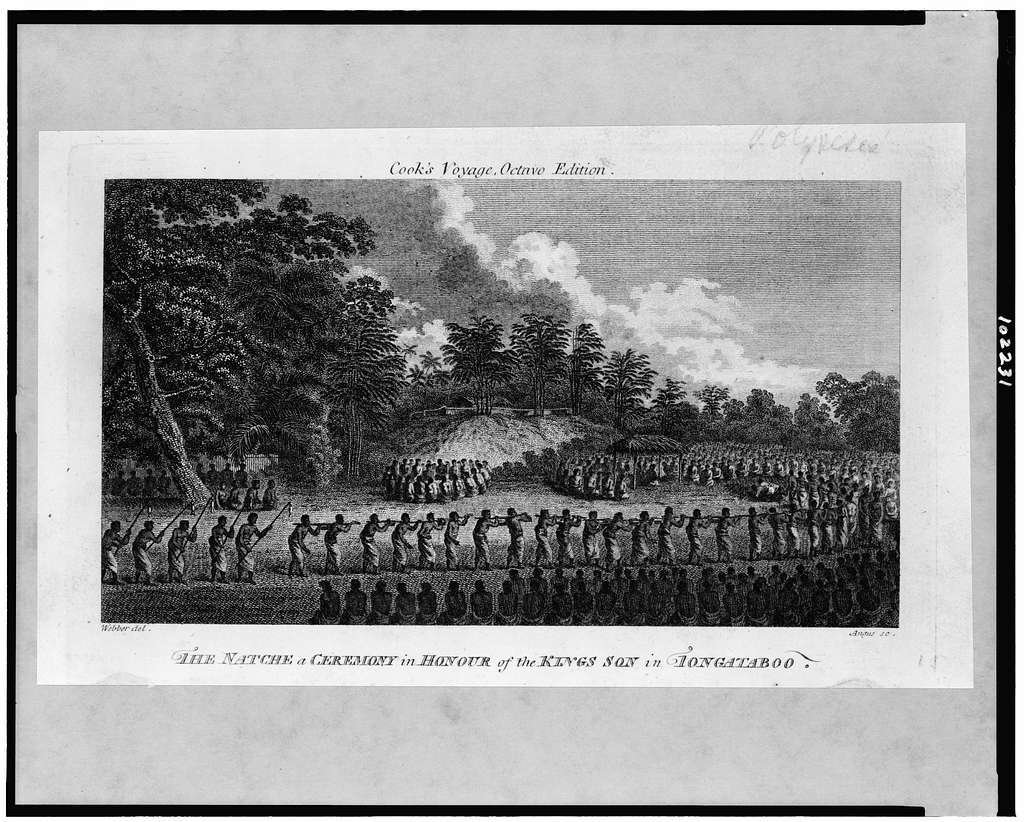
The Natche, a ceremony in honour of the Kings son in Tongatabu, by John Webber. Public Domain {{PD-US}}, Library of Congress.
Christianization and "Protectorate"


The first Christian missionaries arrived in Tonga in 1797. Most significant was the arrival of Methodist missionary Walter Lawry in 1822. In the years that followed, numerous Tongans converted to Methodism.
Tonga became a British "protectorate" in 1900. This meant the British had full power over Tonga's finances and foreign affairs, but Tonga was able to keep its monarchy. This was a unique arrangement in the South Pacific.
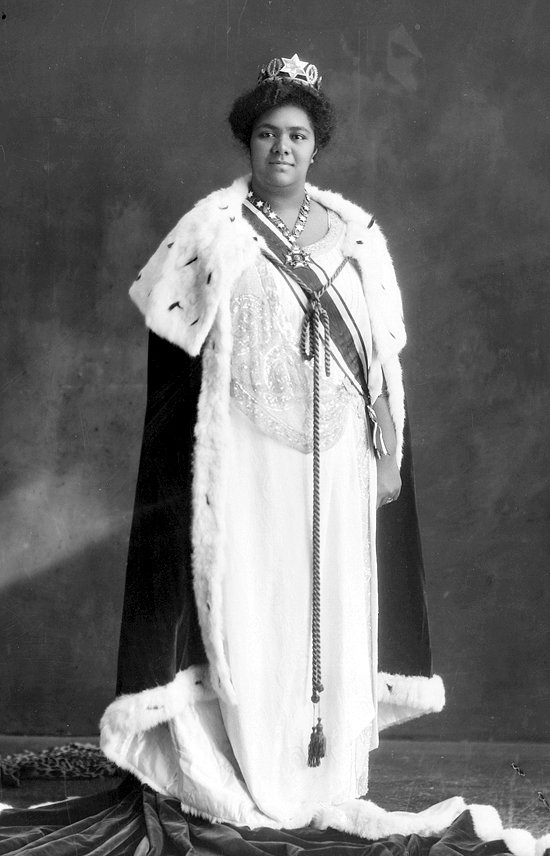
Sālote Tupou III of Tonga in Coronation Robe, unknown artist. {{PD-Tonga}}, via Wikimedia Commons.
Tongan Independence


Towards the end of her 48-year reign (1918-65), Queen Sālote Tupou III began negotiating with the British for full independence. This was achieved in 1970.
Like many other post-colonial societies, Tongans have had many difficult conversations about their identity. What pre-colonial practices should they keep or revive? What should they adopt/adapt from the colonizers and other Western cultures?
This is a performance of Handel's "Hallelujah Chorus" in the Free Wesleyan Church of Tonga" in 2017. The "Hallelujah Chorus" is the most popular piece of Western classical music in Tonga. Following common Tongan practice, the chorus is accompanied by a brass band.
Tonga: Arrival of Brass Bands


Scholar Adrienne Kaeppler conjectures Tongans heard British, French and German bands in the late 19th century, and that brass bands became well established in Tonga by the late 1880s.
The College Band, Nukualofa, Tonga, by Frederick W. Sears. Seddon's trip to the Pacific Islands album. Ref: PA1-o-461-37. Alexander Turnbull Library, Wellington, New Zealand. /records/22910445
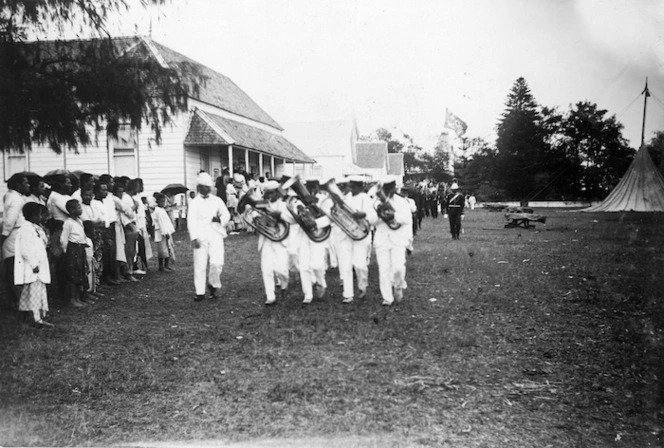
Historians are unsure exactly when brass bands were first introduced to Tonga.
Functions of Brass Bands in Tonga


For more than a century, brass bands in Tonga have played for important occasions, such as weddings, funerals, and the opening of Parliament sessions or important buildings. They also frequently play at church services.
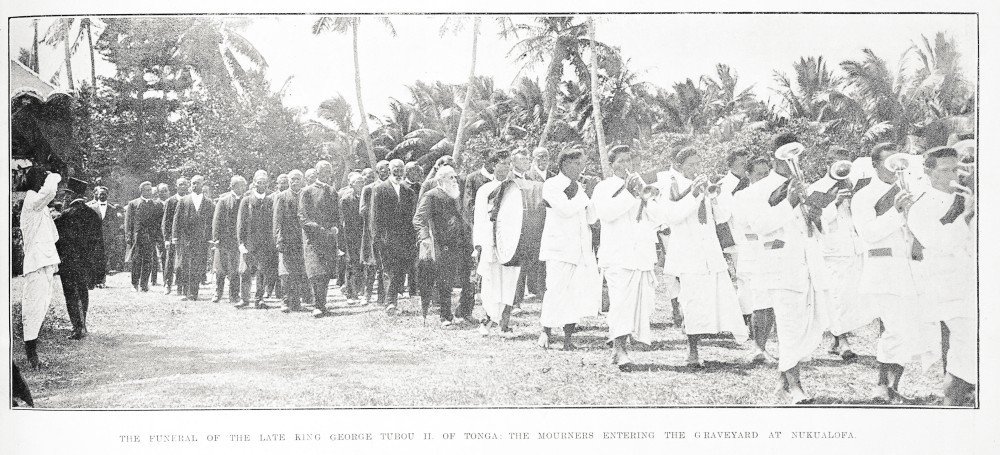
Funeral Procession of King Tupou II Entering the Graveyard in 1918.
Tongan Brass Band Repertoire


Modern-day Tongan brass bands play a wide variety of repertoire.
"Tonga Police Band - Tofa He Si'i Kakala." Uploaded to YouTube by sam molitika. This song was composed by Queen Sālote Tupou III.
Click through the next several slides to listen to some examples.
Brass Bands and Popular Music


Listen to the Tongan Police Brass Band's performance of "Kokomo."
"Tongan Police Brass Band 2013 - Kokomo." Uploaded to YouTube by Paula Moimoi Latu.
What pitch range is emphasized?
How would you describe the timbres in the band?
Sometimes, brass bands play arrangements of popular tunes.
Tongan Brass Bands: Optional Listening


From 1992 to 1992, Leo Florendo (a Peace Corps Volunteer) served as the Band Director ("Fai Ifi") at Taufa'ahau Pilolevu College.
During this time, he made a series of recordings, which underscore the diversity of repertoire performed by Tongan brass bands.
If time allows, explore Florendo's archive--which features arrangements of church hymns, orchestral classics (e.g., 1812 Overture), pop songs (e.g., Rock Around the Clock), famous marches (e.g., Stars & Stripes Forever), local folk songs, and much more!
Brass Bands in the Tongan Diaspora


Some in the Tongan Diaspora seek ways to continue the Tongan brass band tradition in their new homes.
The Sydney (Australia) Tongan Brass Band performs "Fungai Lupe" in Auckland, New Zealand, 2011.
Over the past few decades, many Tongans have sought educational and career opportunities overseas.
Gender and Brass Bands in Tonga


King Tāufa`āhau Tupou IV (reigned 1965-2006), who was a big fan of brass bands, wanted to open this tradition to girls. He therefore sponsored a brass band program at Queen Sālote College (for girls aged 11 to 18).
The Queen Sālote College Music at the 92nd Anniversary Thanksgiving Service, 2018.
Historically, Tongan brass bands have traditionally been overwhelmingly male.
Linikoni Taufa: Tongan American Musician and Teacher


The conductor of the performance you just watched is Linikoni "Koni" Taufa, a Tongan American musician and teacher who grew up immersed in the Tongan Brass Band tradition.
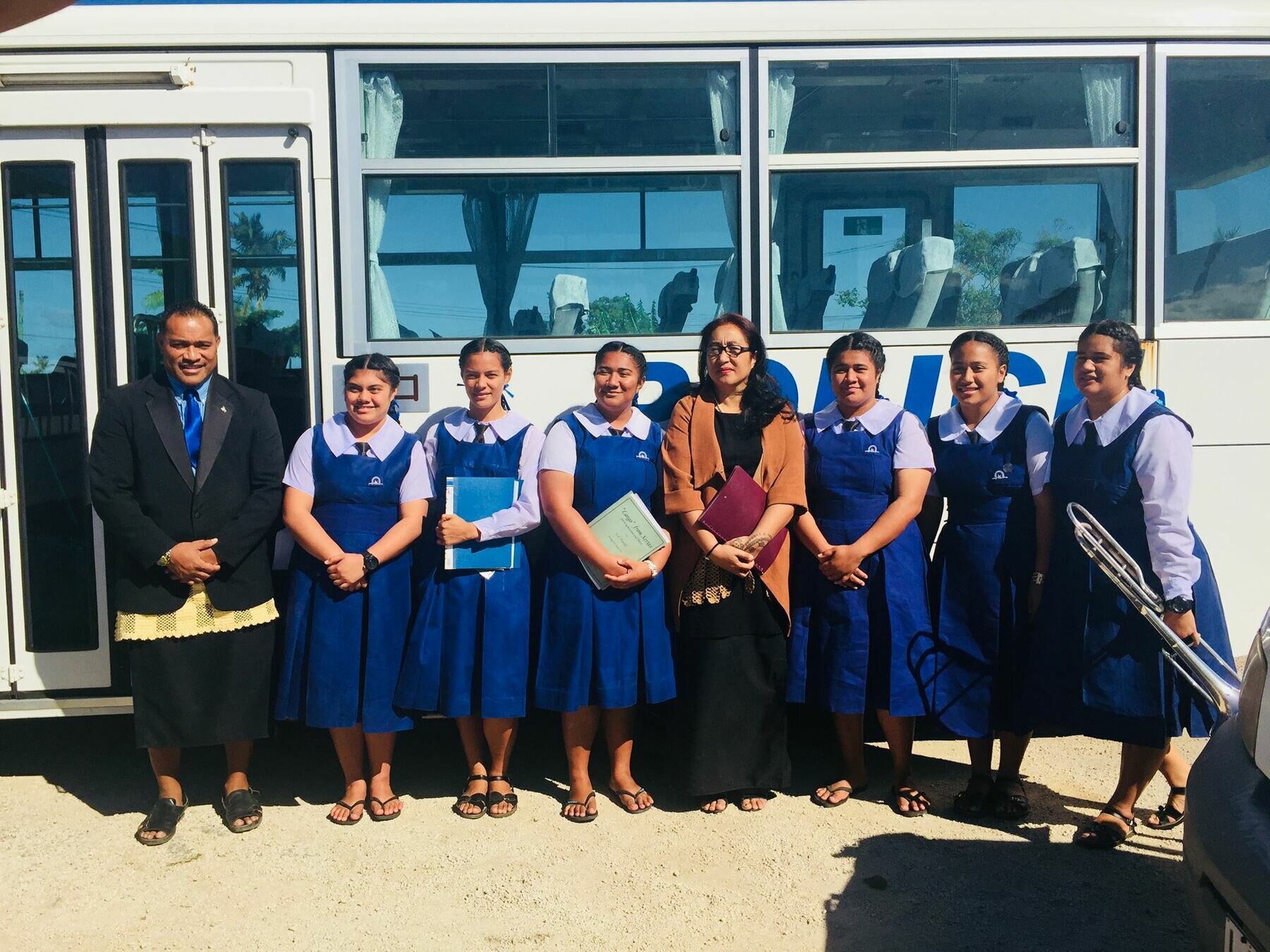
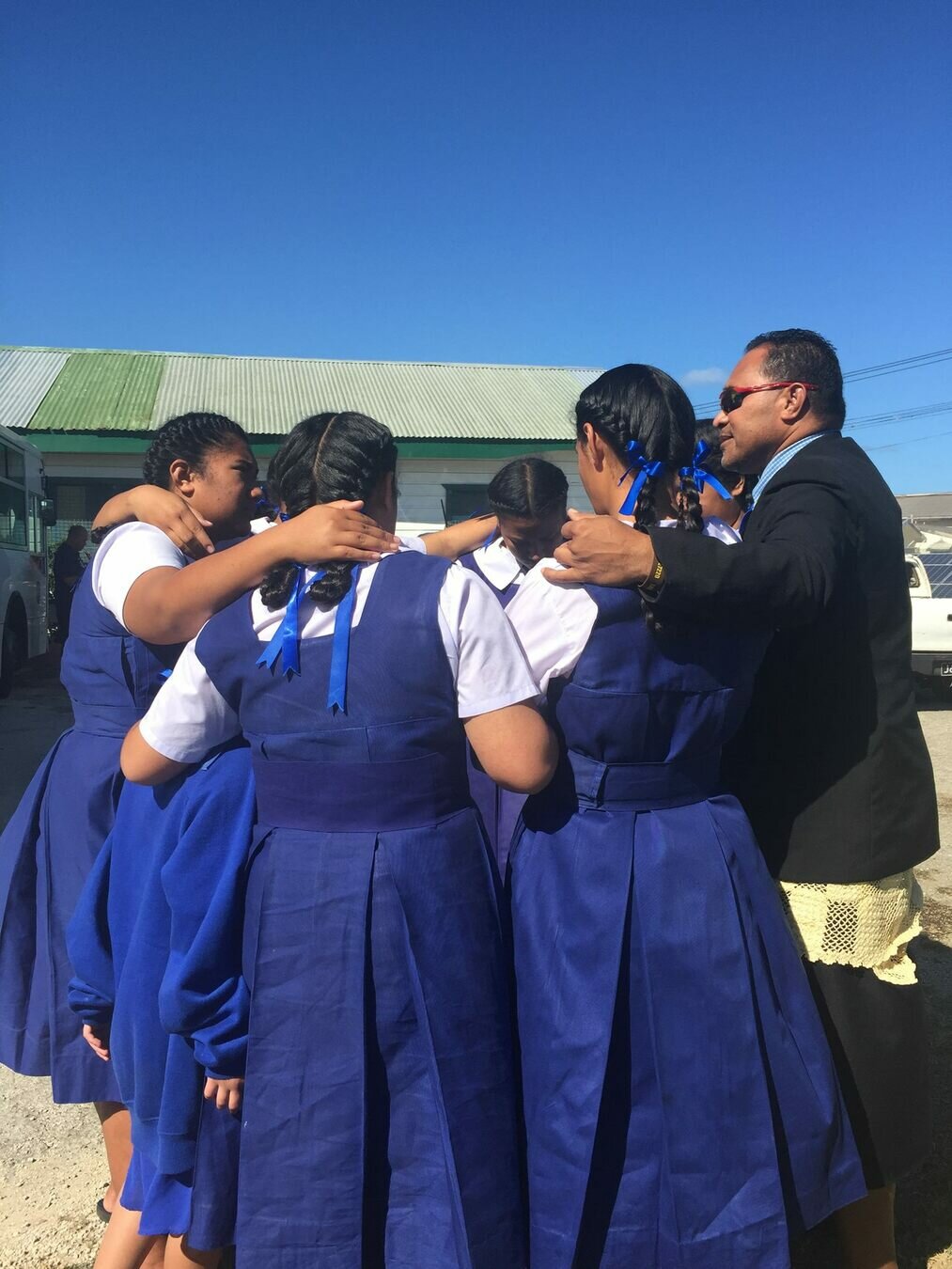
Add Appropriate Caption and Information Here. Photos courtesy of Linikoni Taufa.
Koni's Brass Band Story


When and why did Koni become involved in this tradition? What does it mean to him?
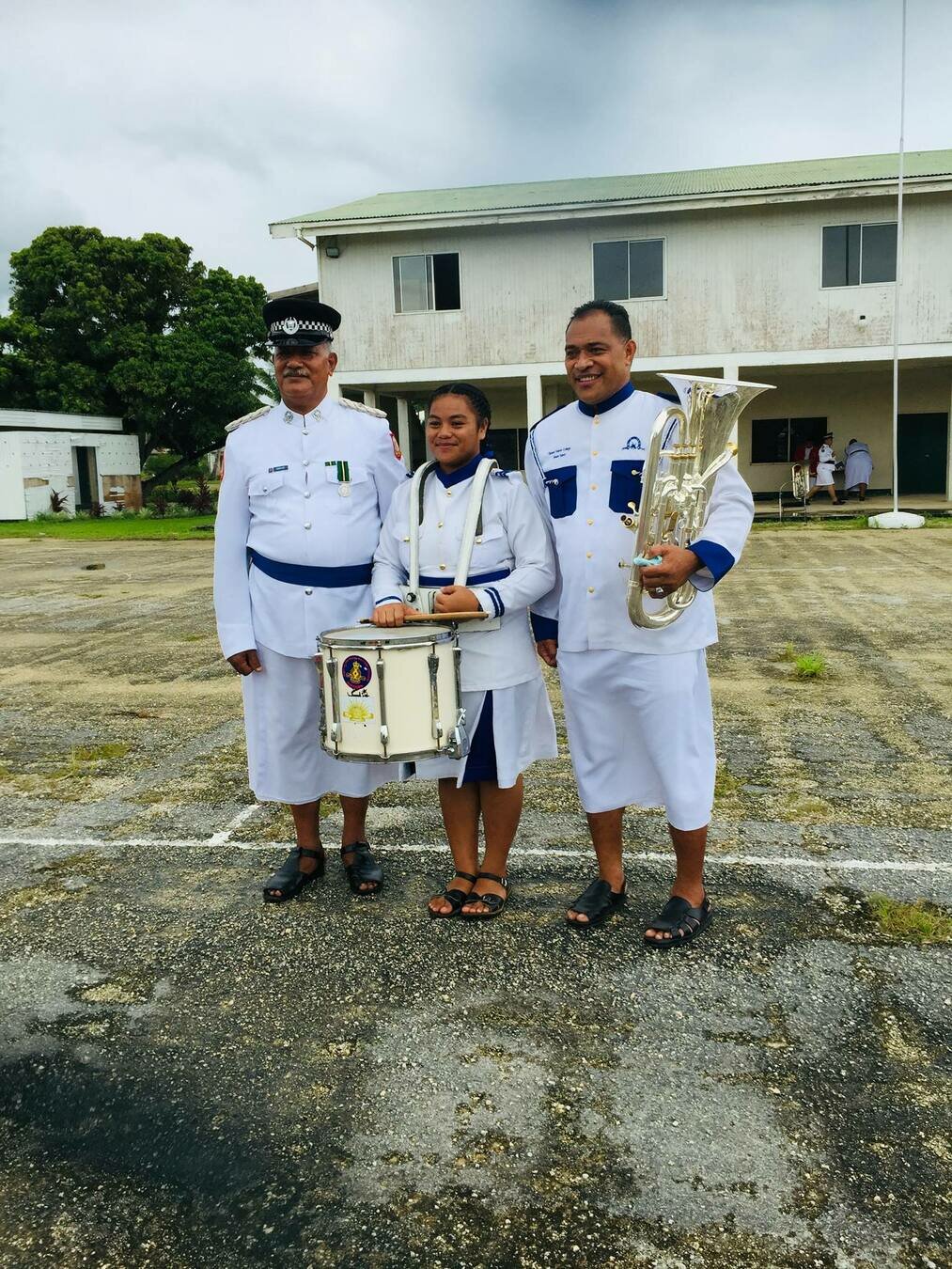
Add Appropriate Caption and Information Here. Photo courtesy of Linikoni Taufa.
Koni's Immigration Story


Peace Corps...meeting Jenny ...getting married...moving to the United States. Becoming a citizen.
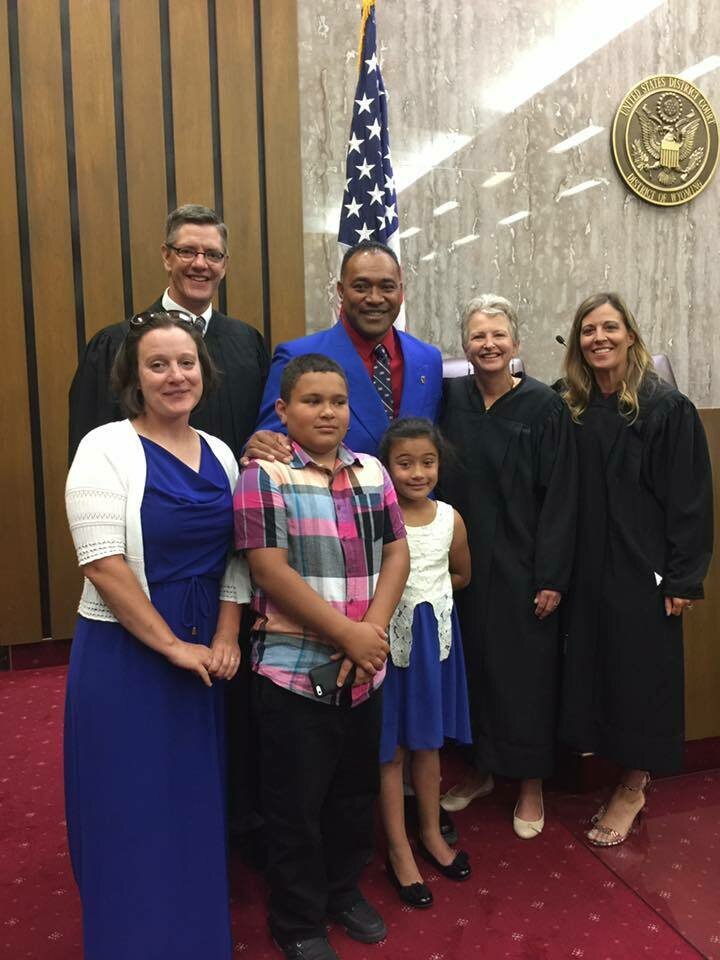
Koni's Immigration Ceremony in ?. Photo courtesy of Linikoni Taufa.
Koni's Current Story


Koni earned a MA in music performance from the University of Wyoming in ?
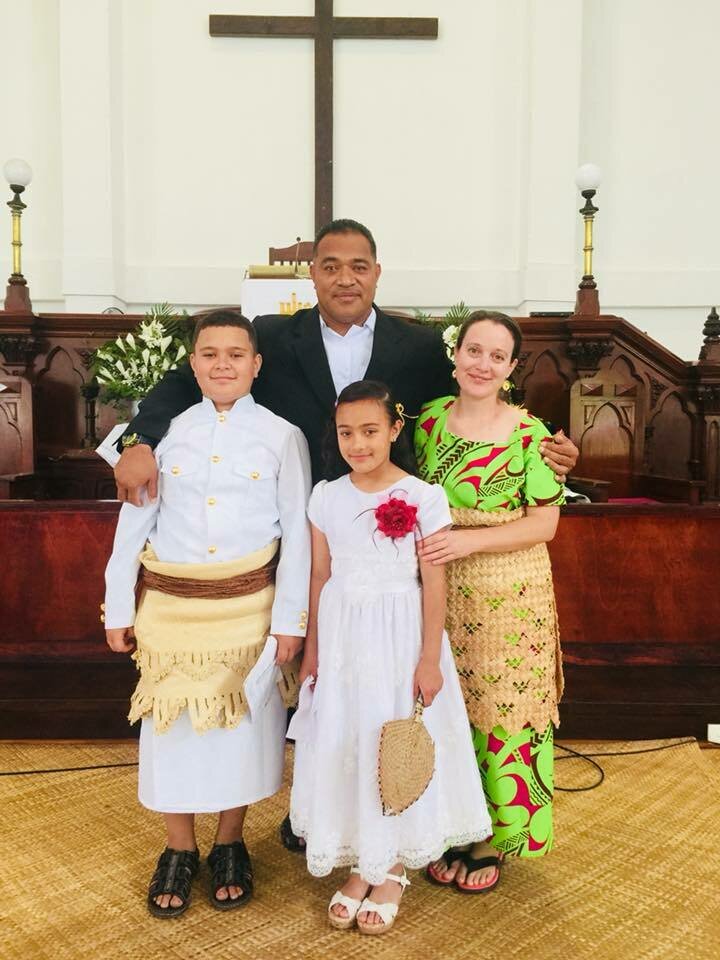
He currently lives in Laramie, WY with Jenny and their two children, Paul and Sia.
He works at Laramie High School, where he works closely with 9th-12th grade students in the band program.
He is also an active member of the local Methodist church community, serving as choir director.
Koni and his Family at Church in ?. Photo courtesy of Linikoni Taufa.
Preserving Cultural Heritage


Language? proficiency level. Sports? brass instruments...anything else (other customs or traditions)?
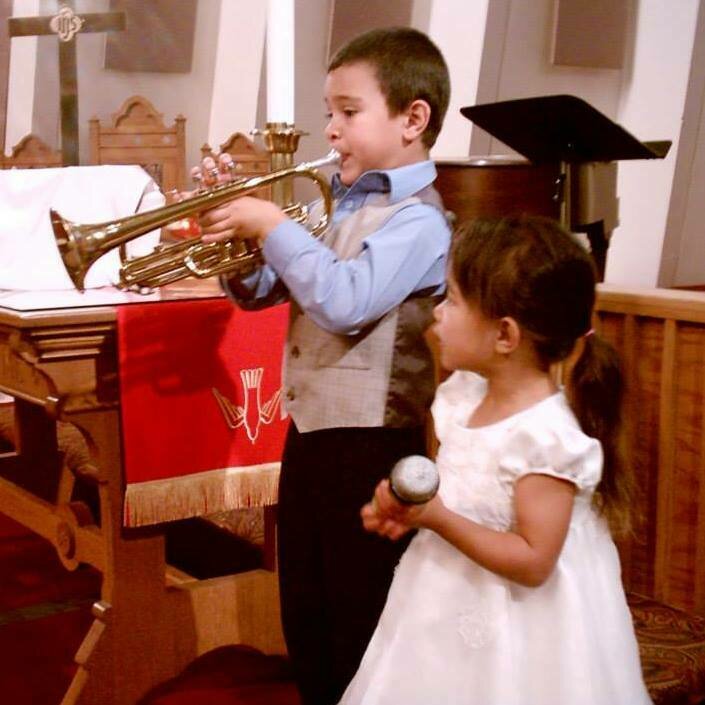
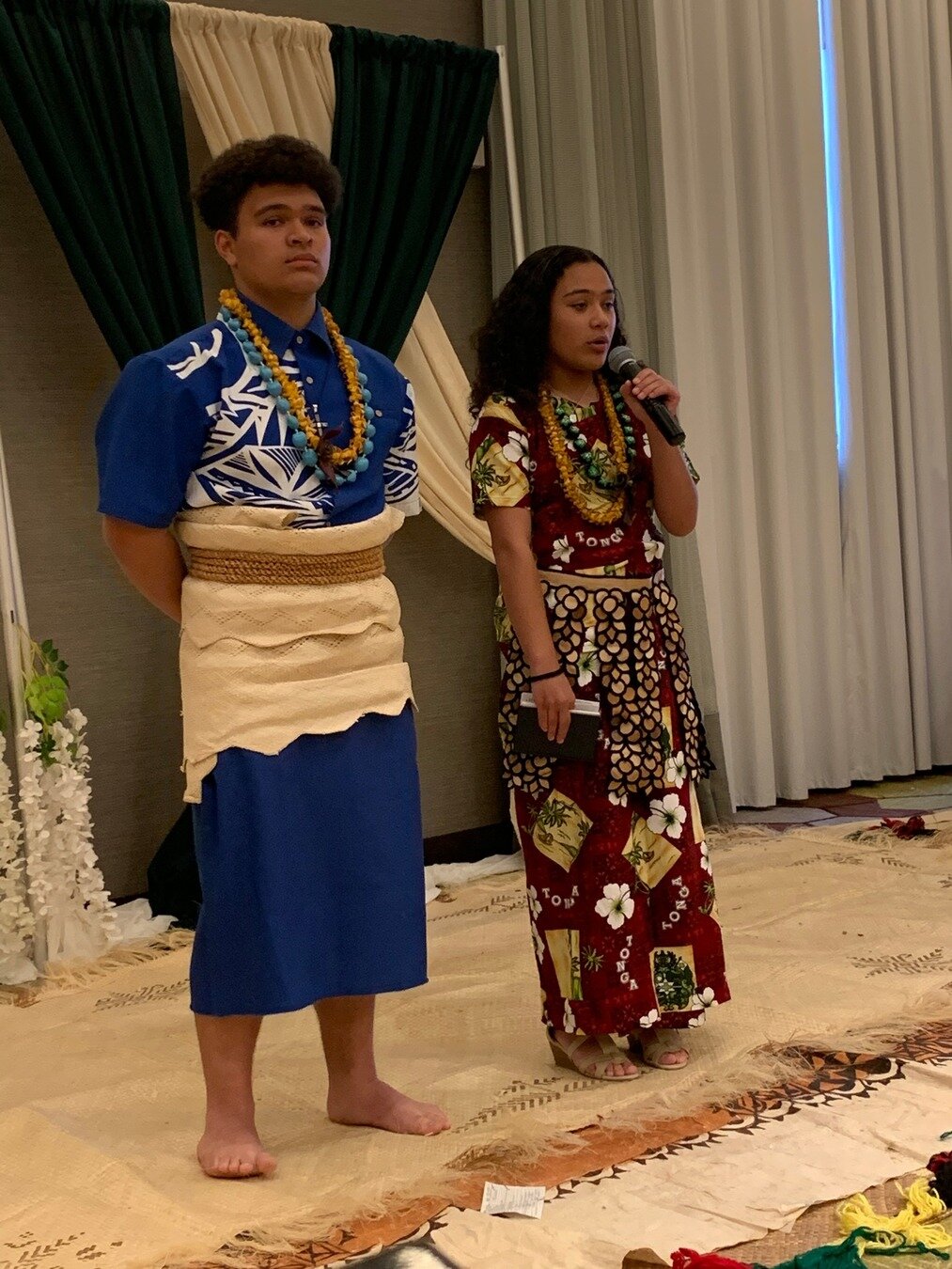
Photos courtesy of Linikoni Taufa.
Preserving Cultural Heritage


Immersion experiences in Tonga and why that was important.
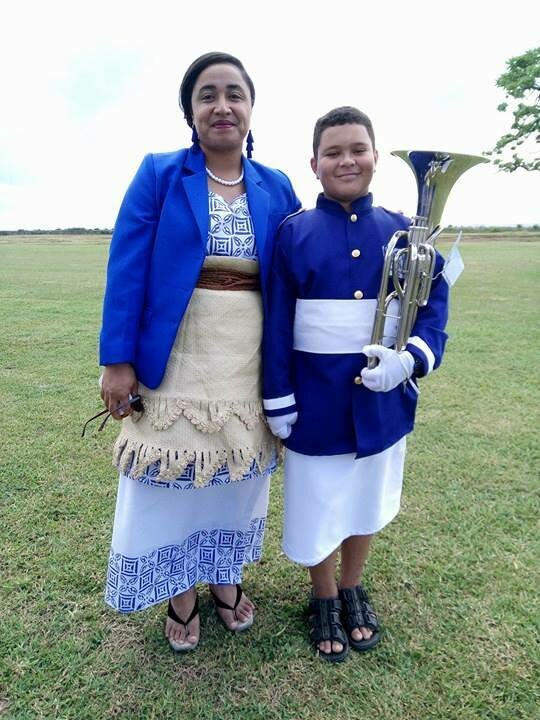
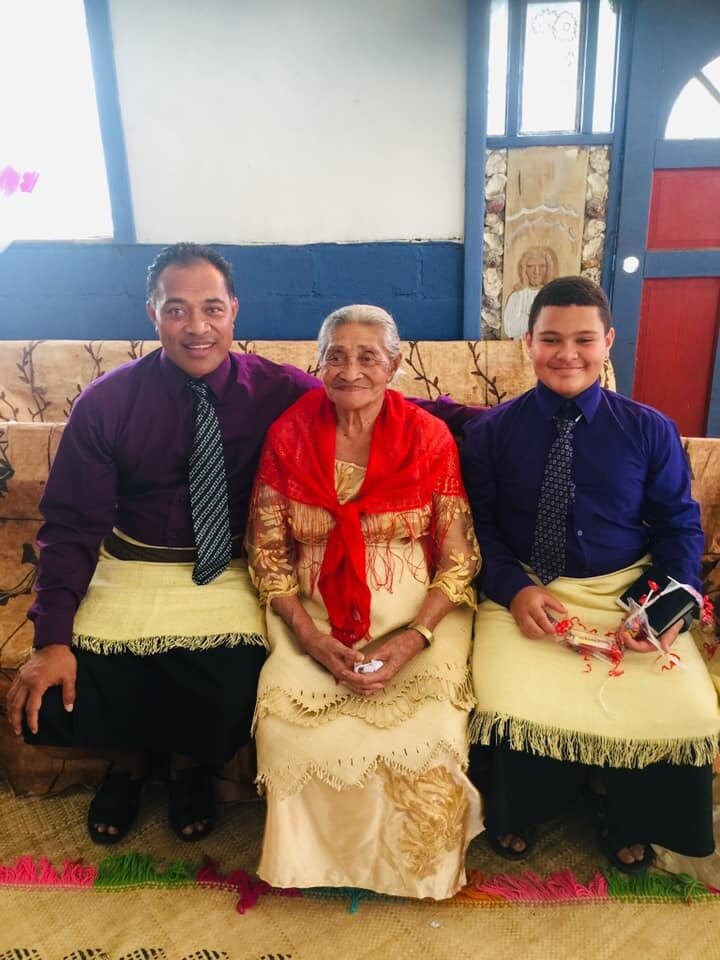
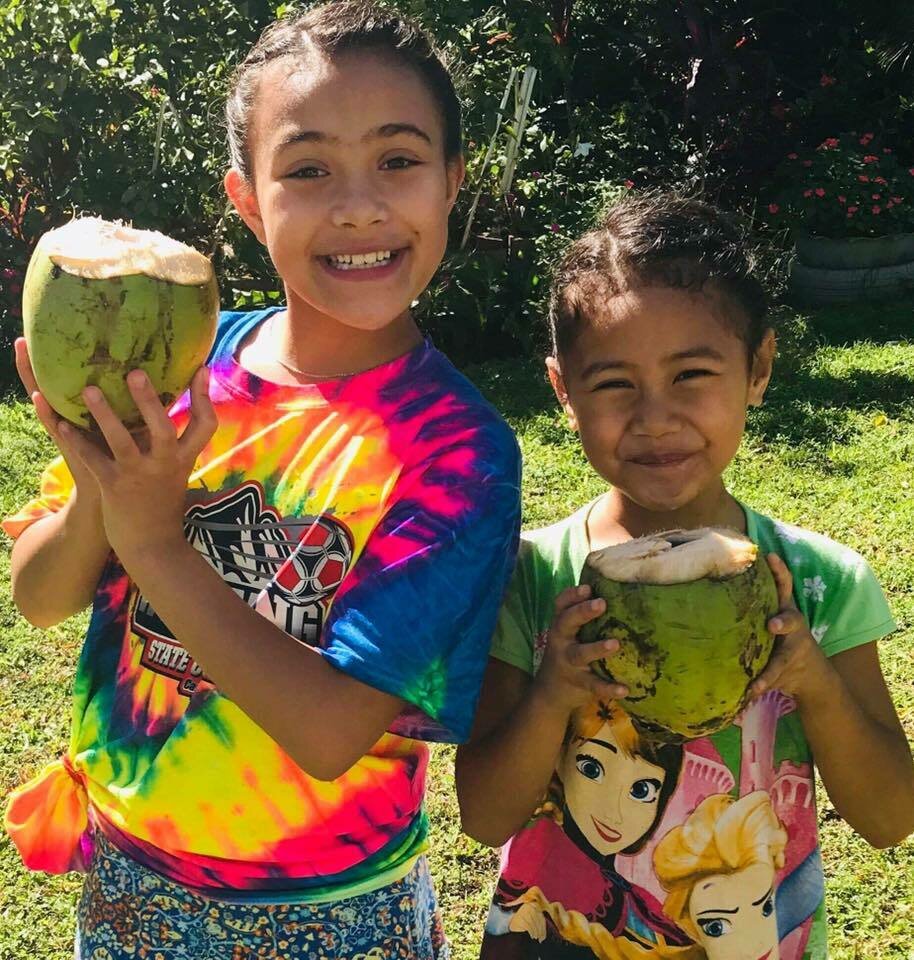
Photos courtesy of Linikoni Taufa.
Merging Cultural Perspectives


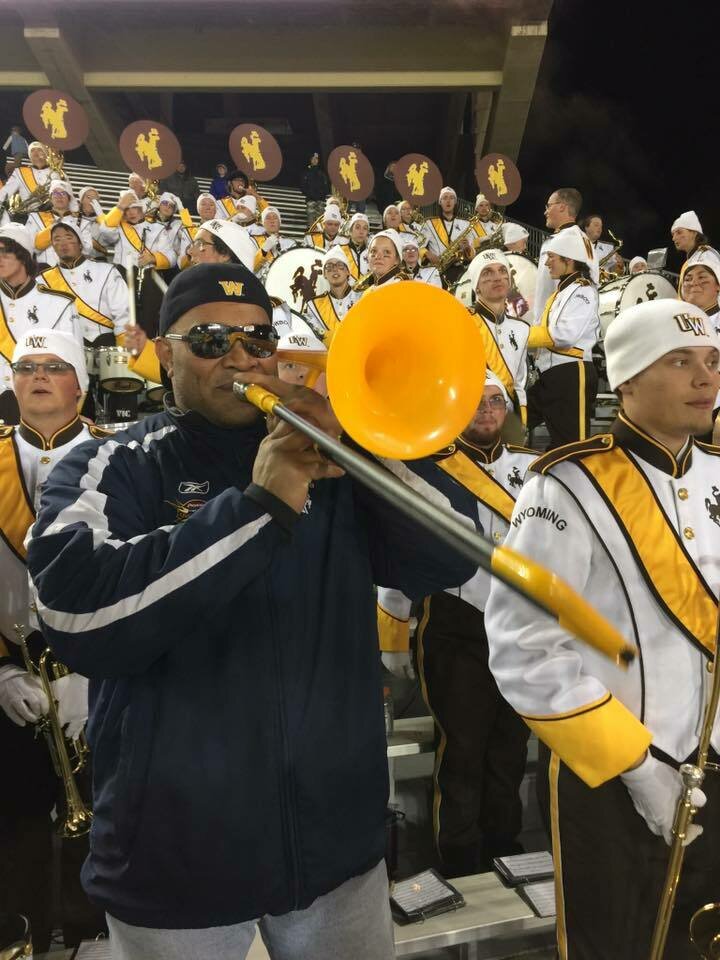
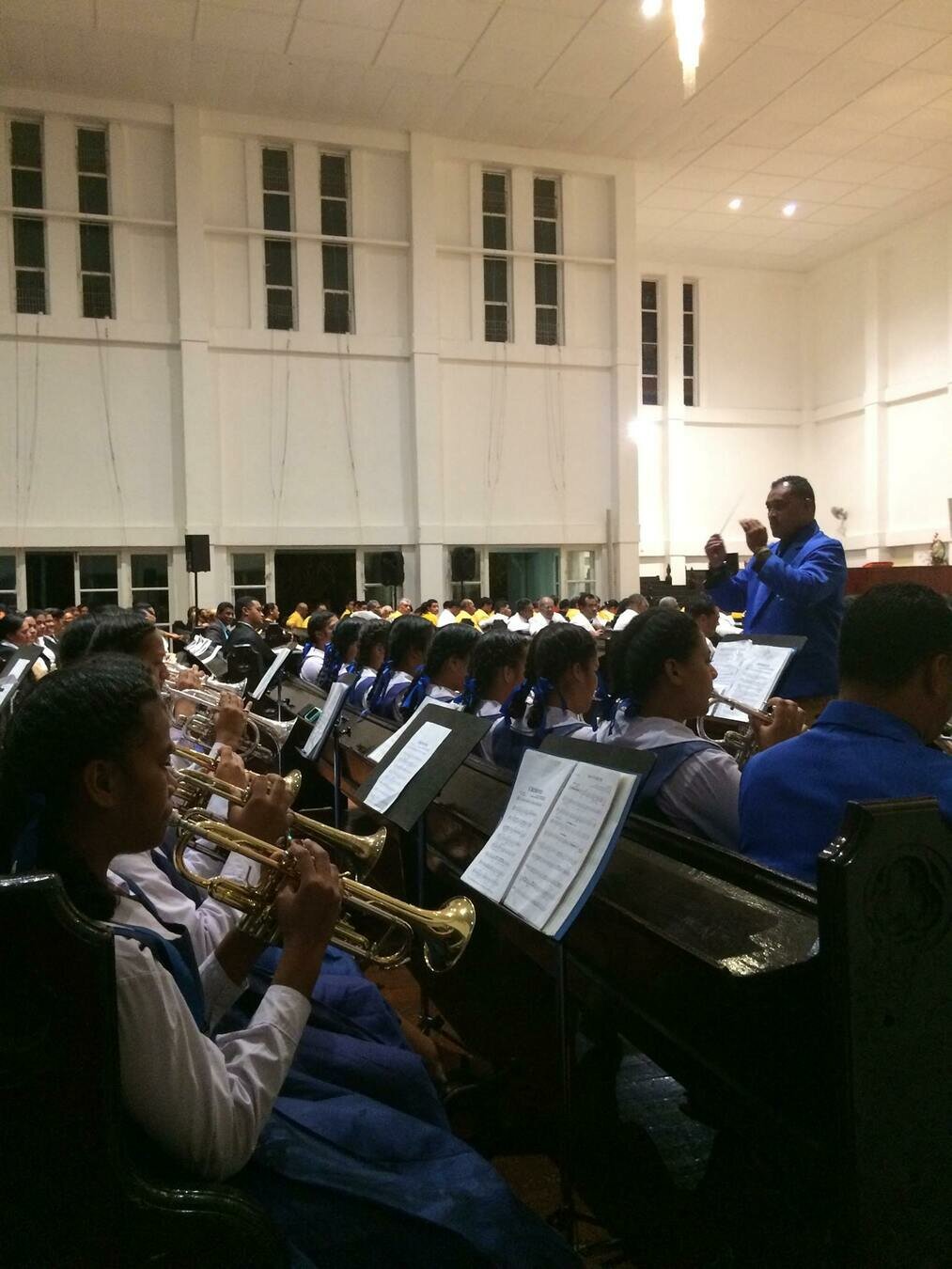
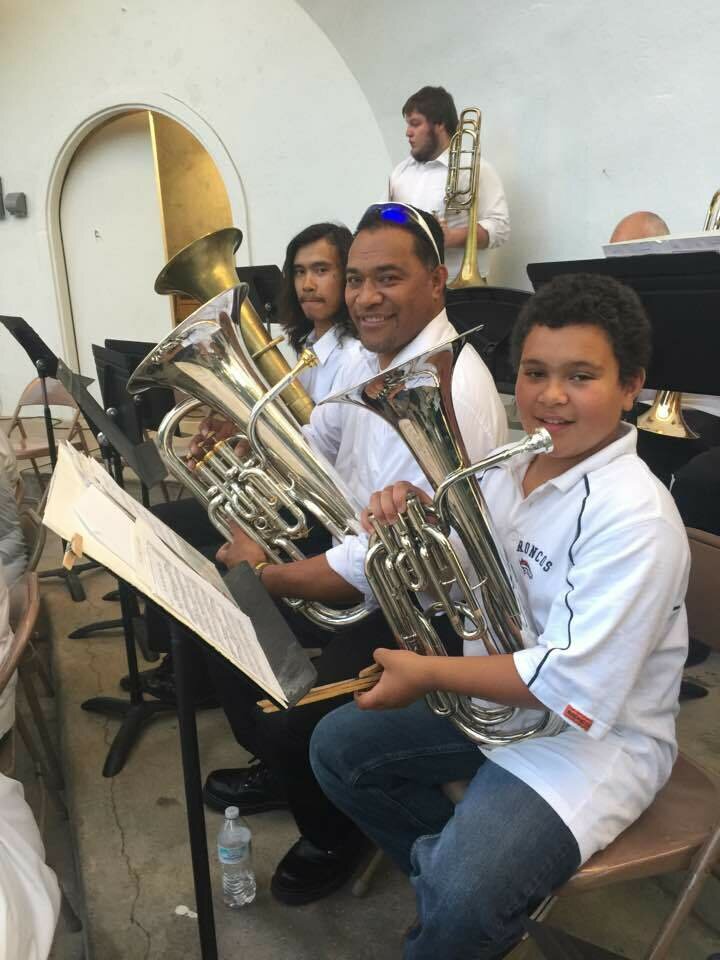
Merging Cultural Perspectives



Right: Koni and Paul Taufa on the University of Wyoming Campus at the "World Language Day" Competition. Photo courtesy of Linikoni Taufa.
Left: In this video clip, Koni and Paul play the US National Anthem for the Wyoming State Swimming Championships and conclude with a "cliff" jump off the high dive.
Merging Cultural Perspectives: Paul


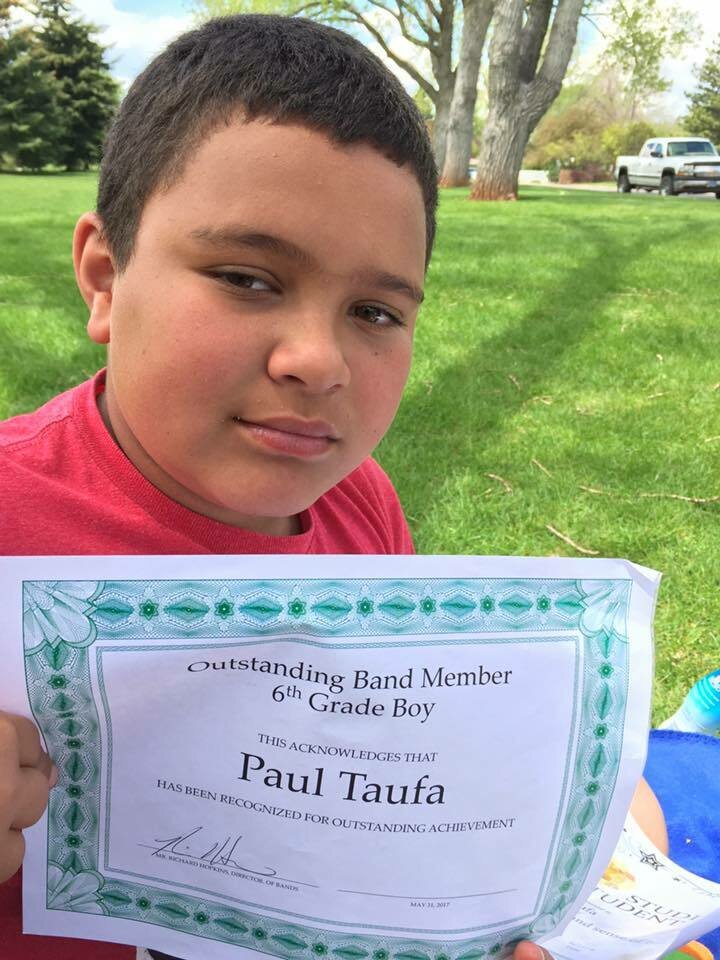
Photos courtesy of Linikoni Taufa.
Merging Cultural Perspectives


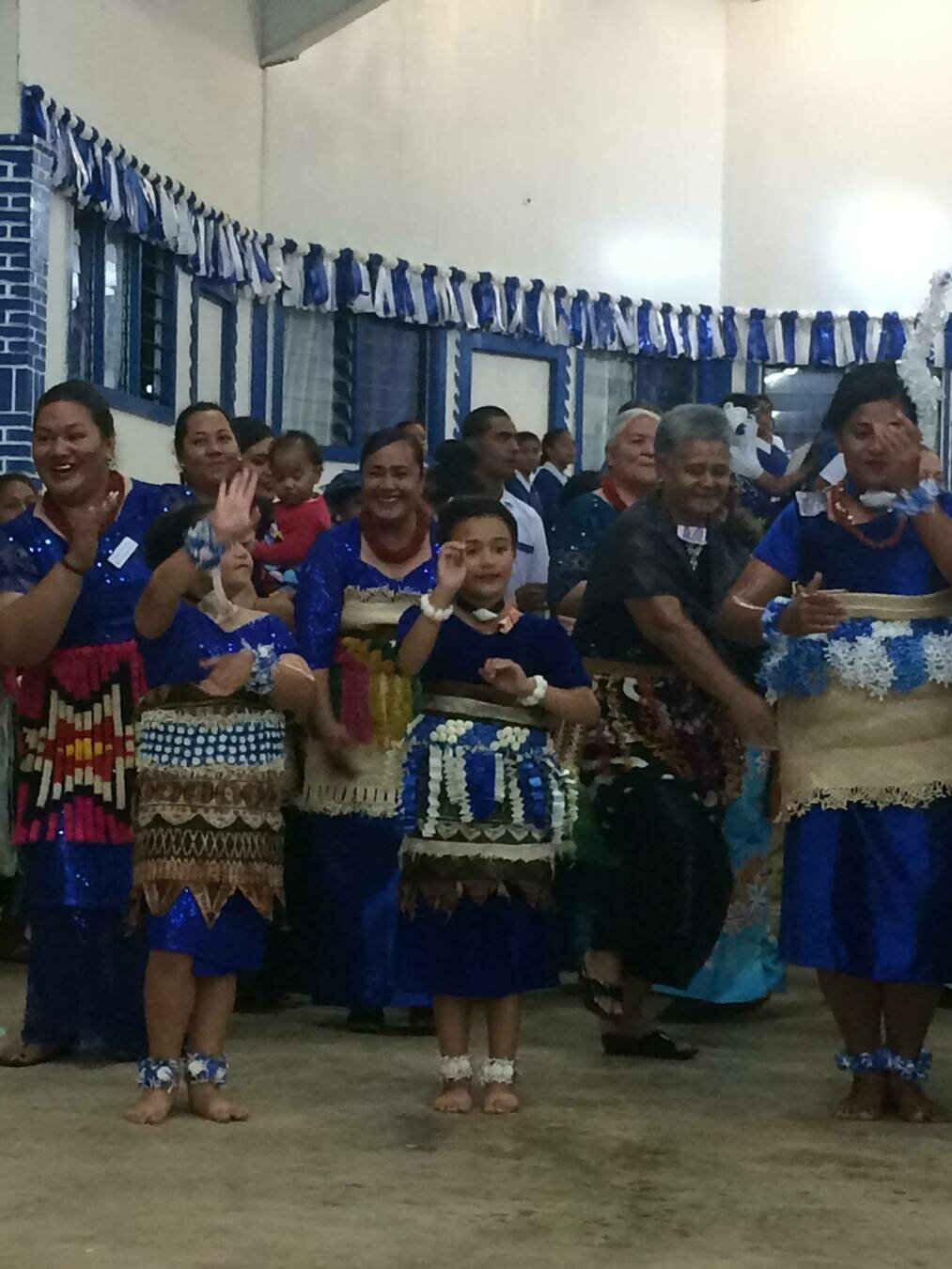

Photos courtesy of Linikoni Taufa.

Learning Checkpoint
- How and why did brass band traditions become established on many Pacific Islands?
- What functions have brass bands served in Tonga? What makes the ensemble so versatile?
- How does Linikoni Taufa (originally from Tonga) attempt to preserve and merge traditions in a new home (the United States)?

End of Component 2: Where will you go next?




Creating Art About Cultural Heritage
Component 3

20+ minutes
Loa Greyson, a Los Angeles-Based Singer-Songwriter and His Father, the Legendary Samoan Musician Fa’anānā Jerome Grey.



Music and Cultural Heritage
Throughout this learning pathway, we have encountered numerous examples of Asian American, Native Hawaiian, and Pacific Islander American artists who use music to evoke their cultural heritage.
Some incorporate musical traditions from their cultural heritage in their compositions. One example is Nobuko Miyamoto's "Tampopo (Dandelion)," which uses a Japanese drumming tradition called taiko.

Nobuko Miyamoto. Cover designed by Visual Dialogue, photo by Michael Becker, Smithsonian Folkways Recordings.


Music and Cultural Heritage
Some evoke a "feel" associated with their cultural heritage. Many Native Hawaiian musicians, such as slack-key guitarist Ledward Kaapana, work to achieve a sense of "nahenahe."
Nahenahe is an aesthetic that places an emphasis on softness, sweetness and melodiousness. Value is placed on achieving an "apparent effortlessness."

Ledward Kaapana, photo courtesy of the artist.
"Wai Okeaniani"


Music and Cultural Heritage
Some talk about their cultural group's experiences and histories. An example is No-No Boy's (Julian Saporiti's) "Tell Hanoi I Love Her."
Julian's mother fled Vietnam in 1968, shortly after his great-grandfather was killed during the Tet Offensive. This song captures his conflicting feelings about his family's history in Vietnam.


Music and Cultural Heritage
Some establish ensembles that continue and adapt traditional music from their homeland. An example is Chum Ngek, who teaches traditional Cambodian classical music (pinpeat) in Maryland and Virginia.
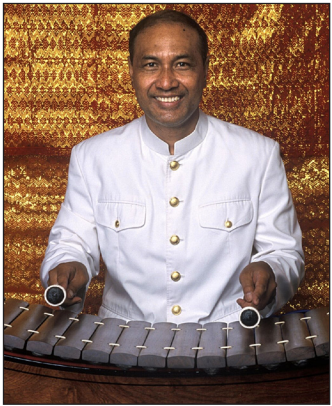
Chum Ngek, photo by Robin Kent. Smithsonian Folkways Recordings.
"Chamreang Agangamasor"


Music and Cultural Heritage:
New Pacific Islander American Examples
In this video (NA'LÅ'LA' x/Give Life), the artist delivers a message about harmony and balance with the natural world (lessons from ancestors) in an urban space.
Dakota Camacho (aka Infinite Dakota) is a Matao/CHamoru artist based in dxʷdəwʔabš land (the Indigenous name for Seattle). He is passionate about creatively using art to express indigenous ways of knowing.


Music and Cultural Heritage:
New Pacific Islander American Examples
In this video, Loa Greyson, a Los Angeles-based singer-songwriter of Samoan descent, sings "Malieota." The song was written by him and his father, the legendary Samoan musician Fa’anānā Jerome Grey. It is a tribute to Malieota Tanumafili II: the King of Samoa from 1962–2007.

What is Cultural Heritage?

According to UNESCO, cultural heritage is "the legacy which we receive from the past, which we live in the present and which we will pass on to future generations."

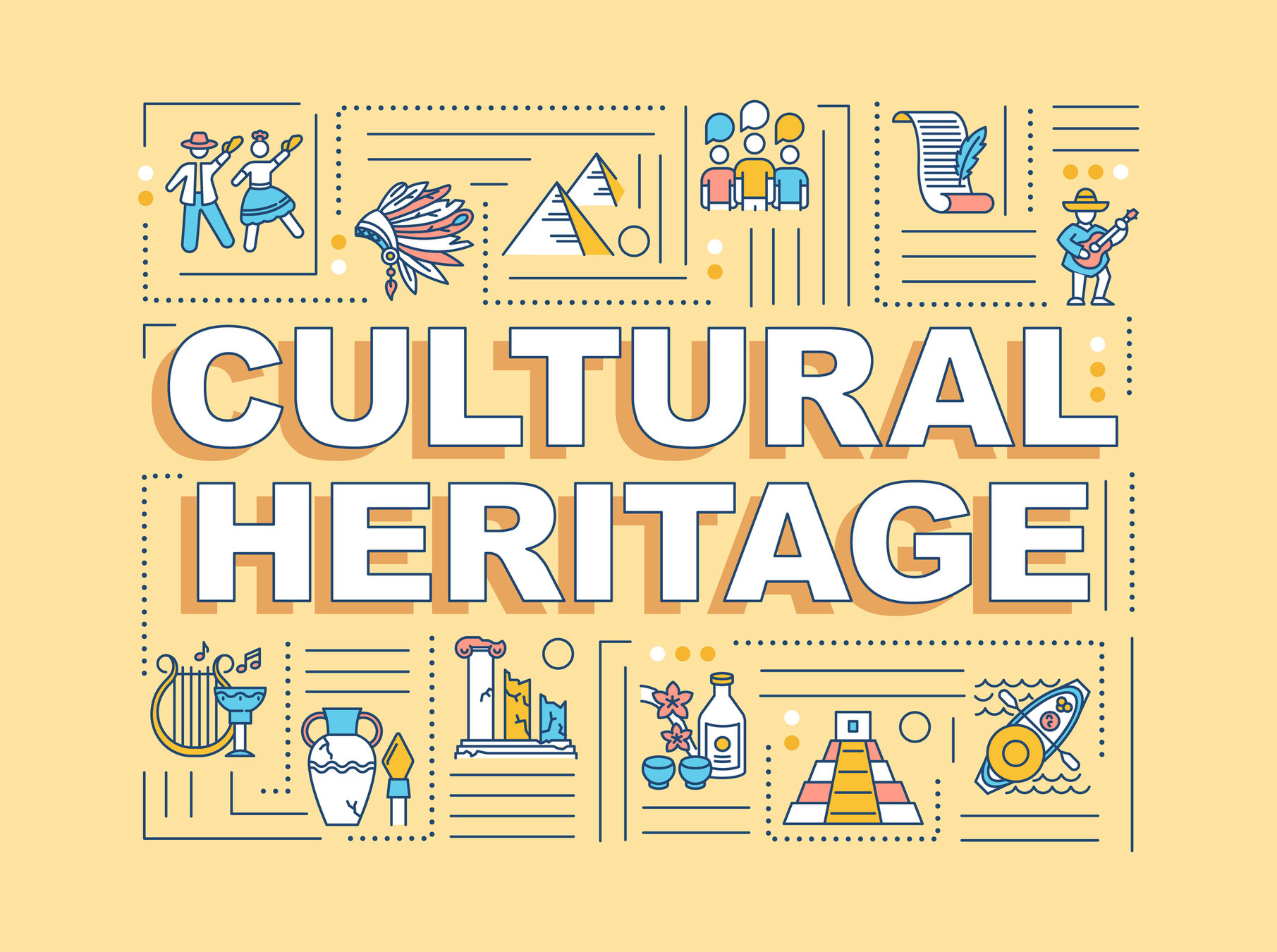
What are some key aspects of your cultural heritage?
Cultural Heritage, by bsd555. iStock by Getty Images.

Music and Cultural Heritage: Personal Connections
Think about the previous examples of how Asian Americans, Native Hawaiians, and Pacific Islander Americans have created art about their cultural heritage.
Can you think of any songs that you connect with because they reflect your cultural heritage? What are they?
How could you create art that reflects your cultural heritage? What landscape, folk art or concept might you use as inspiration? When creating art that reflects your cultural heritage, what ethical questions might arise?


Activity: Research or Create
Option 1: Do some research on how artists from one or more of your cultural heritages have incorporated their cultural identity into their work. Then, discuss what you found in small groups or as a class.

Option 2: Create a work (e.g., painting, song, short story, poem, animation) that showcases one or more of your cultural identities in some way. Show or perform this work for your class. Then, discuss what you did, why you made creative decisions, and your thoughts about the finished product.

Learning Checkpoint

- Can you think of any songs that you connect with because they reflect your cultural heritage? What are they?
- How could you create art that reflects your cultural heritage?
- How did the artists featured in this component create music about their cultural heritage?
- What is cultural heritage?
End of Component 3 and Lesson 4: Where will you go next?







Lesson 5 Media Credits

© 2022 Smithsonian Institution. Personal, educational, and non-commercial uses allowed; commercial rights reserved. See Smithsonian terms of use for more information.
This project received Federal support from the Asian Pacific American Initiatives Pool, administered by the Smithsonian Asian Pacific American Center.
For full bibliography and media credits, see Lesson 5 landing page.
Audio courtesy of
Smithsonian Folkways Recordings
Video courtesy of
Smithsonian Folkways Recordings
Images courtesy of
Tafesilafa'i, Inc.
University of Iowa Libraries
Library of Congress
University of North Texas Libraries
University of Texas Libraries
Highland Support Project
New York Public Libraries
The Arhoolie Foundation
National Library of New Zealand




